
Wetland&Science Practice Vol. 42, No. 2 April 2024 ISSN: 1943-6254 published by the Society of Wetland Scientists
 Ralph Tiner WSP Editor
Ralph Tiner WSP Editor
It feels like Spring is here or just around the corner. As I write this in early March, the vernal pools in western Massachusetts are filled to the brim as we’ve had quite a bit of rain these last few weeks. I would expect that the Spotted and Jefferson Salamanders may have already started their annual migration from upland forests to local vernal pools. They along with Wood Frogs and Spring Peepers do this here on rainy nights in March and April when temperatures are above 40° F. So, I expect that Wood Frogs will soon be chorusing in the vernal pools behind my house. Our local sugar houses have been open for business for some time now as most began tapping the Sugar Maples early this year...in mid-January due to a mild winter. In years past, March was the prime time for sugaring but for some time now the tapping season has begun earlier — a trend, not an isolated occurrence, suggesting it is a product of climate change. A friend of ours with a local sugaring operation said he got a late start this year. Last year he produced over 150 gallons and so far, this year he has made only 70 gallons. When we visited his sugar shack on Saturday, he was producing dark syrup which comes from late season sap. It has a stronger maple flavor and is my favorite. He said he even started to tap Black Birch trees as their sap flows later than the maples. When my wife and I were in Alaska this summer we sampled some birch syrup made from the sap of White Birch produced by the Alaska Birch Syrup & Wild
Harvest Shop in Talkeetna. Where it takes about 50 gallons of sap to make 1 gallon of maple syrup, it takes an average of 110 gallons of birch sap to make 1 gallon of birch syrup because its sap has a much lower sugar content.
I hope all of you enjoyed our January issue as it took quite an effort to produce...thanks again to all the contributors and Tatiana Lobato de Magalhães who coordinated the Latin America and Caribbean Wetlands issue.
For the April issue we have three articles. Arnold van der Valk has added to his interesting series of articles on pioneers of wetland science — this one deals with efforts to control Water Hyacinth and how that evolved into a professional scientific organization focused on managing wetlands (i.e., to keep them free of this invasive species). Gillian Davies and colleagues have contributed an article updating the status of the Rights of Nature in Wetlands initiative. The third article is a profile on one of our Wetlands of Distinction — Bunchgrass Meadows in Washington State — by Colin MacLaren. In addition to those articles, we have reviews for three books — Streams of Revenue: The Restoration Economy and the Ecosystem It Creates (MIT Press), Bayou-Diversity: Nature and People in the Louisiana Bayou Country (LSU Press), and Bayou D’Arbonne Swamp: A Naturalist’s Memoir of Place (LSU Press). You’ll also find Notes from the Field showing some of my observations in and around wetlands that I visited this summer.
Special thanks again to all our contributors. Meanwhile, I want to reach out to members to see if any of you have an interest in working with me as an Assistant Editor for WSP (see the notice posted under SWS News in this issue for details). If questions about the process, let me know.
Happy Swamping!
THE EDITOR’S DESK 168 Wetland Science & Practice APRIL 2024
FROM
CONTENTS
ISSN: 1943-6254
168 / From the Editor’s Desk
170 / President’s Address
171 / SWS Webinars
172 / SWS News
176 / Commemoration of David Mitchell
196 / Book Reviews
198 / Notes From the Field
205 / Wetlands in the News
206 / Wetland Bookshelf
207 / SWS Submission Guidelines
208 / 2023 Advertising Prospectus
ARTICLES:
177 / The World’s Most Troublesome Weed: Water Hyacinth and the Development of Wetland Science
Arnold van der Valk
185 / Rights of Nature in Wetlands – Transformative Change for Securing the Future of Wetlands Through Effective Restoration
Gillian Davies, Max Finlayson, Matthew Simpson, William Moomaw, and Siobhan Fennessy
192 / Bunchgrass Meadows — Among Our Wetlands of Distinction
Colin MacLaren
COVER PHOTO:
Moose calf (Alces alces) at Horseshoe Lake, Denali National Park, Alaska. This one was seen nursing. (Photo by Ralph Tiner)
Wetland&Science Practice
PRESIDENT / Susan Galatowitsch, Ph.D.
PRESIDENT-ELECT / Eric Stein, Ph.D.
IMMEDIATE PAST PRESIDENT / William Kleindl, Ph.D.
SECRETARY GENERAL / Kai Rains, Ph.D.
TREASURER / Lori Sutter, Ph.D.
TREASURER-ELECT/ Yvonne Vallet, SPWS, SWSPCP
EXECUTIVE DIRECTOR / Erin Berggren, CAE
MARKETING MANAGER / Moriah Meeks
WETLAND SCIENCE & PRACTICE EDITOR / Ralph Tiner, PWS Emeritus
CHAPTERS
ASIA / Wei-Ta Fang, Ph.D.
CANADA / Susan Glasauer, Ph.D.
CENTRAL / Lindsey Postaski
CHINA / Ming Jiang
EUROPE / Matthew Simpson, PWS
INTERNATIONAL / Alanna Rebelo, Ph.D. and Tatiana Lobato de Magalhães, Ph.D., PWS
MID-ATLANTIC / Adam Gailey
NEW ENGLAND / April Doroski
NORTH CENTRAL / Casey Judge, WPIT
OCEANIA / Maria Vandergragt
PACIFIC NORTHWEST / Josh Wozniak, PWS
ROCKY MOUNTAIN / Rebecca Pierce
SOUTH ATLANTIC / Richard Chinn
SOUTH CENTRAL / Jessica Brumley
WESTERN / Richard Beck, PWS, CPESC, CEP
SECTIONS
BIOGEOCHEMISTRY / Katie Bowes
EDUCATION / Darold Batzer, Ph.D.
GLOBAL CHANGE ECOLOGY / Melinda Martinez, Ph.D.
PEATLANDS / Bin Xu, Ph.D.
PUBLIC POLICY AND REGULATION / John Lowenthal, PWS
RAMSAR / Nicholas Davidson, Ph.D.
STUDENT / Deja Newton
WETLAND RESTORATION / Luke Eggering
WILDLIFE / Rachel Fern
WOMEN IN WETLANDS / Mo Wise
COMMITTEES
AWARDS / Amanda Nahlik, Ph.D.
EDUCATION AND OUTREACH / Jeffrey Matthews, Ph.D.
GLOBAL REACH / Rebecca Woodward
HUMAN DIVERSITY / Kwanza Johnson
MEETINGS / Yvonne Vallette, PWS
MEMBERSHIP / Kai Rains, Ph.D.
PUBLICATIONS / Keith Edwards
WAYS & MEANS / Lori Sutter, Ph.D.
WETLANDS OF DISTINCTION / Roy Messaros, Ph.D., Steffanie Munguia and Jason Smith, PWS




REPRESENTATIVES
PCP / Christine VanZomeren
WETLANDS / Marinus Otte, Ph.D.
WETLAND SCIENCE & PRACTICE / Ralph Tiner, PWS Emeritus
NAWM / Samantha Vogeler
AIBS / Dennis Whigham, Ph.D.
Vol. 42, No. 2 April 2024
to Readers: All State-of-the-Science reports are peer reviewed, with anonymity to reviewers. SOCIETY OF WETLAND SCIENTISTS 1660 INTERNATIONAL DR., STE 600, MCLEAN, VA 22102 (608) 310-7855
Rounded squar
Note
WWW.SWS.ORG
 Susan Galatowitsch, Ph.D. University of Minnesota SWS President
Susan Galatowitsch, Ph.D. University of Minnesota SWS President
Dear SWS Colleagues,
The SWS Board of Directors (BOD) recently wrapped up the “Mid-year” meeting, which was held remotely, with the Executive Board convened in Chicago. As part of our very full agenda, all of the Chapter, Section, and Committee Chairs reported on their recent activities and plans. It is inspiring to take in the span of activities, accomplishments, and aspirations from across SWS. Webinar events are clearly on the rise with many chapters and sections reporting on a terrific array of offerings held in the past year and planned for the coming months. Many chapters highlighted their work to broaden the geographic reach of their membership as well as student awards for travel.
A highlight of the BOD meeting was approval to create a new SWS Section, “Rights of Wetlands” (ROW). This new section will serve as a forum to facilitate interactions among SWS wetland scientists, Indigenous Peoples and Local Communities, policymakers, wetland managers, and other groups or people who are engaging with the many aspects of the Rights of Wetlands. They will provide a symposium at each SWS Annual Meeting to explore the Rights of Wetlands as a wetland conservation, restoration, and management strategy supported by wetland science and represent SWS in global interactions involving Rights of Wetlands, such as at Conferences of the Parties of the Ramsar Convention and other conferences.
The Rights of Wetlands Section began as an initiative of the ad hoc Wetlands Concern Committee. For the past few years this group has explored emerging wetland protection mechanisms based on the inherent standing of nature. Globally, Indigenous Peoples and Local Communities (IPLC) are leading on championing ROW and this section can offer support for wetland scientists and professionals who are affiliated with or partner with IPLC. Already the ROW group has published a number of ROW articles (both peer-reviewed journal articles and Wetland Science & Practice articles), successfully advocated for the operationalization of Rights of Wetlands by the UN Environment Programme, won a Darwin Initiative grant to explore and develop approaches to implementing ROW in five developing countries (Kenya, Sri Lanka, Ecuador, Guyana, and Bolivia) and hosted symposia and events at the Ramsar COP14, and several SWS, SER, and INTECOL conferences.
The ROW section will be led by Gillian Davies, President, Max Finlayson (Vice-Chair, Secretary: Nick Davidson (Secretary), and Siobhan Fennessy (Treasurer). As a SWS member, you are invited to join this new section: contact info@sws.org if you are interested. Many thanks to Gillian, Max, Nick, Siobhan, and the rest of the ROW committee who led the effort to create this new section and who have advanced our understanding of the Rights of Wetland and advocated for its “place at the table” for wetland conservation.
Wishing you success with all of your wetland endeavors!
Sue Galatowitsch SWS President
170 Wetland Science & Practice APRIL 2024
PRESIDENT'S ADDRESS
English:

April 18 | 1:00 PM ET
Vanishing Ice: Wetland Rehabilitation for Infrastructure Installations in Permafrost
Speaker: Lorene Lynn, CPSS, CERP
May 16 | 1:00 PM ET
Wetlands of Nebraska Outreach and Education
Project: Accomplishments and Transferability
Speaker: Ted LaGrange
June 20 | 1:00 PM ET
Topic TBD
Speaker: TBD
Spanish:
June 19 | 1:00 PM ET
Topic TBD
Speakers: TBD
NOTE: Webinar Topics and Speakers are subject to change. Visit the SWS Event Calendar for the most recent details and for future webinar dates.
THANK YOU TO OUR 2024 WEBINAR SERIES SPONSORS



Wetland Science & Practice APRIL 2024 171
Renew Your SWS Membership by April 30th!
The membership renewal grace period ends on April 30th. Renew your SWS membership for 2024 in the InfoHub. Log in here using the email address associated with your SWS membership.
If you have not logged in to the system in some time and it does not recognize your email, click the “Create One” link and enter your name and email to set up your account. From there, head to ‘My Billing Info’ to pay your 2024 dues.
Do you need to add or change your Chapter or Section membership? Contact us at info@sws.org, and our team will assist you with these updates.
Make sure to pay your dues to ensure that you maintain your SWS membership benefits!
We hope you have found your SWS membership to be beneficial and will consider staying with us. If you have any questions or concerns, contact info@sws.org
In Search of Assistant Editor of Wetland Science & Practice
Having been the editor of Wetland Science & Practice for a decade or so, it is time to get someone ready to move the journal forward after mid-2025. During my tenure, we’ve been able to take the journal into the digital realm as a full-color e-publication and have re-established the process of assigning doi codes to articles to make them more readily available online. To make the transition seamless in anticipation of my retirement by 2026, we’d like to have someone come onboard as an Assistant Editor (AE) for the next year or so with the expectation that the AE would assume the Editor’s position by the end of 2025. The duties would be to help the Editor contact local chapters for possible contributions, review contributions for their suitability for publication and suggest edits, coordinate any additional peer review as necessary, and learn the process of working with our support staff in getting the issue posted online. In terms of a time commitment, most issues require about 3-4 days of work from the Editor so the AE would spend a day or so four times a year. As far as qualifications are concerned, the best candidates would have some experience in writing scientific papers/publications and articles for the general public on the ecology or natural history of wetlands. FYI, the Society’s budget includes a travel stipend for the Editor to attend the Society’s annual meeting. If interested, please send a note to me...Ralph Tiner, Editor WSP at: ralphtiner83@gmail.com. Thanks for your consideration.
Submit Nominations for the 2024 SWS Awards
We are pleased to announce that the Society Awards Season is officially open!
The SWS Awards Committee will be accepting nominations through Wednesday, May 1 for the following awards:
• Fellow Award
• Human Diversity Award
• International Fellow Award
• International Travel Award
Submit nominations for the awards listed above here.
• Merit Award
• Outstanding Educator Award
• Practitioner Award
• SWaMMP Champion Award
Submit nominations for the awards listed above here.
Find descriptions for all SWS awards here.
172 Wetland Science & Practice APRIL 2024 SWS NEWS
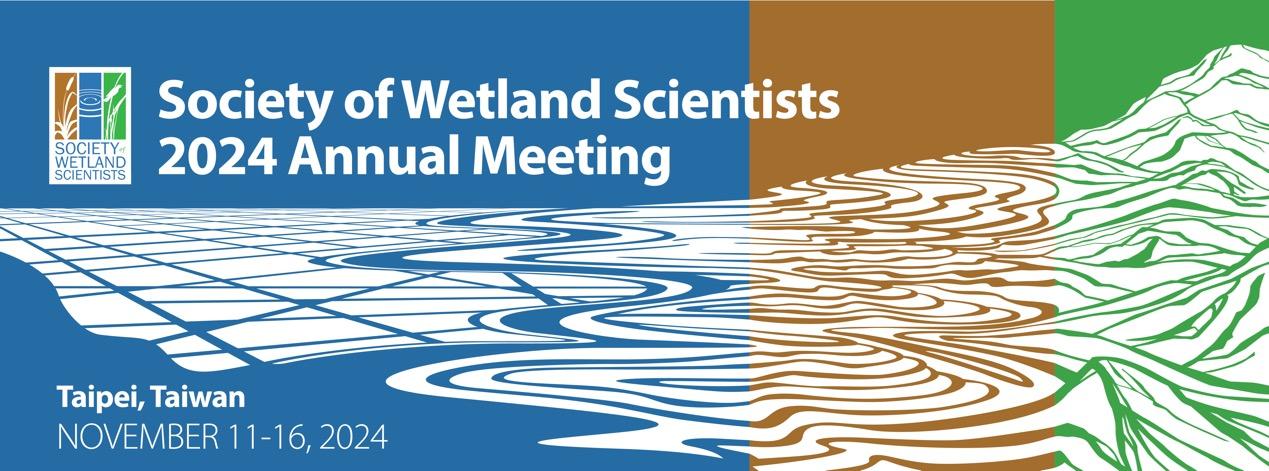
REGISTRATION NOW OPEN!
Exciting News! Registration for the SWS 2024 Annual Meeting is now open. Join us in Taiwan this fall for SWS’s first Annual Meeting in Asia.
One of SWS’s core values is to promote global wetland conservation, and we are eager to come together in Taiwan to achieve this goal with our members in 2024.
Register Now
NOW ACCEPTING ABSTRACTS
Submit abstracts for oral and/or poster presentations. Abstracts from all related disciplines and areas of expertise from all practitioners (academics, consultants, and governments) are welcome. The meeting is an opportunity for wetland scientists and related interests to exchanges information and knowledge.
Abstract Submission Deadline: May 15th
(Acceptance notification: June 15th)
Submit Absstracts Here

2024 World Wetlands Survey
We need your input! Share details about a wetland you’re familiar with in our ongoing participatory science study on global wetland status, a follow-up to 2017 and 2020. Whether providing updates on previously surveyed areas or introducing new entries, we value information on wetland size and condition.
Survey Deadline: April 30, 2024
Complete the Survey
Wetland Science & Practice APRIL 2024 173 SWS NEWS
Student Virtual Conference
The fight against climate change is everybody’s business, and students are at the forefront of fighting for a better future. Come hear the latest research on global warming, wetland restoration, hydrology, biology, and climate change from our perspectives. Cultivate discussions on policy and mitigation, and strategies for combatting climate change. Conference presentations will be invited and contributed.
REGISTRATION COSTS
Student (SWS member): $35.00
Student (non-member): $55.00*
SWS member (non-student): $75.00
Super Supporter SWS member (non-student): $100.00
Non-member & Non-student: $125.00
*The student non-member registration fee comes with an annual student membership for SWS!
TENTATIVE SCHEDULE
*All times/agenda items are drafted in EST (UTC -05:00) and subject to change. Details will be added in the coming weeks.
Friday, April 5th
8:00–9:00am - Opening Plenary Speaker
9:00am–12:00pm - Workshops/Talks
12:00–1:00pm - Lunch break
1:00–5:00pm - Symposia/Talks
Now Accepting HumMentor Applications
Saturday, April 6th
8:00–9:00am - Opening Plenary Speaker
9:00am–12:00pm - Symposia/Talks
12:00–1:00pm - Lunch break
1:00–5:00pm - Workshops/Talks
The SWS International Chapter and Education Section are pleased to announce that applications are being accepted for the HumMentor program in 2024–2025! HumMentor is a mentoring program sponsored by SWS for senior undergraduate and early graduate students from Latin America and the Caribbean (LAC) countries who are conducting research or scientific outreach in wetland science.
Application materials submitted to the HumMentor program must be in English, except for student transcripts. However, the HumMentor selection committee understands that English may not be the first language of applicants, and you will have the option to upload materials in your native language (Spanish, Portuguese, or French) on the application form.
Application Deadline: May 15, 2024
Learn More & Apply
U.S. Fish and Wildlife Service Releases Latest National Wetlands Trends Report
The U.S. Fish and Wildlife Service’s National Wetlands Inventory has released its latest wetland status and trends report. It is the sixth of a series of congressionally mandated reports to Congress that span 70 years. The report provides scientific estimates of wetland area in the conterminous United States and of change in area between 2009 and 2019. It also discusses drivers of wetland change and offers recommendations to reduce future wetland loss. The report, a factsheet, common Q&As, and a story map can be found at this link: https://www.fws.gov/project/2019-wetlands-status-and-trends-report
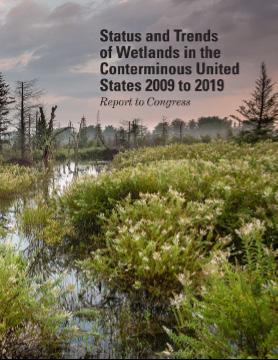
174 Wetland Science & Practice APRIL 2024 SWS NEWS
SWS Board Approves Rights of Wetlands Section! Join Now!
At the February 12, 2024 SWS Board of Directors meeting, the Board approved the establishment of a new SWS Rights of Wetlands Section. A number of SWS members have been working actively to advance Rights of Wetlands (ROW) ever since the 2019 SWS Annual Meeting in Providence, RI, where the group first initiated ROW discussions, gave a presentation on the topic at both the Ramsar Section and Public Policy & Regulations Section symposia, and started making plans to draft a Universal Declaration of the Rights of Wetlands. If you are interested in joining the Rights of Wetlands Section, contact us at info@sws.org, and our team will assist you with updating your membership.
During the pandemic lockdown, we drafted an open access journal article https://www.publish.csiro.au/MF/MF20219 setting out the case for, and creating a Universal Declaration of the Rights of Wetlands, now accessible on the ROW website: https://www.rightsofwetlands.org/. Supplementary material for the article https://www.publish.csiro.au/mf/acc/ MF20219/MF20219_AC.pdf provides a timeline for the expansion of the circle of rights holders through time, including recognition of rights of nature across many cultures throughout history. Following this initial publication, several other articles have ensued, including a guide on how to operationalize ROW: https://www.rightsofwetlands.org/howtodeliver
Additional activities have included giving symposia and presentations at SWS and other conferences and hosting a side event at the 2022 Ramsar Convention on Wetlands Conference of the Parties. The group is collaborating with the Kichwa Original Peoples of Sarayaku in Amazonian Ecuador, who have a Declaration on the Living Forest https://kawsaksacha.org/. Recently the two groups developed a joint statement, which was released at a side event co-sponsored by the Sarayaku and ROW Initiative scientists and policy specialists at the September 2023 UN Climate Week in New York City.
The Declaration has been endorsed by close to 30 organizations https://www.rightsofwetlands.org/support including SWS, Society for Ecological Restoration, Wetlands International, Wildfowl & Wetlands Trust, and the Community Environmental Legal Defense Fund. Further, Rights of Wetlands are being recognized at high levels in the global wetland policy world, as evidenced by the inclusion of operationalization of Rights of Wetlands on the UN Environment Programme’s website: https://sdgs.un.org/partnerships/operationalization-universal-declaration-rights-wetlands#:~:text=Rights%20of%20 Wetlands%20declares%20that%20all%20wetlands%20are,should%20possess%20legal%20standing%20in%20courts%20 of%20law. The broader Rights of Nature were acknowledged in the Kunming-Montreal Global Biodiversity Framework agreed through the Convention on Biological Diversity (https://www.cbd.int/gbf/).
The new ROW Section has been established:
1. To create a forum to facilitate interactions among SWS wetland scientists, Indigenous Peoples and Local Communities, policymakers, wetland managers, and other groups or people who are engaging with the many aspects of the Rights of Wetlands.
2. To provide a symposium at SWS Annual Meetings to explore the Rights of Wetlands as a strategy for wetland conservation, restoration, and management.
3. To provide up-to-date information on Rights of Wetlands to the SWS membership and to others involved in wetland science, conservation, restoration, and management.
4. In consultation with the Executive Board, represent SWS in global interactions involving Rights of Wetlands, such as at Conferences of the Parties of the Ramsar Convention and other conferences.
5. To develop interactions and partnerships with other organizations and groups that are external to SWS who also focus on Rights of Wetlands/Nature. These interactions and collaborations help raise the SWS profile (and interest in joining SWS) as an international wetlands organization, in addition to further developing support for Rights of Wetlands.
6. Raise the SWS profile at international and national scales, thus supporting Strategic Plan goals to further internationalize the Society and build membership.
The ROW Section supports the SWS Strategic Plan Goals, including elements in Goal 1 on Communication, Goal 2 on Education and Research, Goal 3 on Global Reach, and Goal 4 on Membership.
We hope you will join the new Section and attend our anticipated symposium at the SWS Annual Meeting in Taiwan.
Interim Section officers are as follows:
Interim Chairperson: Gillian Davies, PWS
(SWS Member No. 2181)
Interim Vice Chair: C. Max Finlayson
Interim Secretary: Nick Davidson
Interim Treasurer: Siobhan Fennessy
Wetland Science & Practice APRIL 2024 175 SWS NEWS
Commemoration of David Mitchell, past recipient of the SWS International Fellow Award
Sadly our colleague and friend David Mitchell passed away on 18 March 2024. David was a past President of the Australian Freshwater Science Society in 1982 and received their main award in 1995. He was a member of SWS for many years, receiving the Society’s International Fellow Award in 2003.
David was an enthusiastic promoter of aquatic science coming from his background with wetland plant ecology and management and with constructed wetlands for wastewater treatment was very focussed on consultation and participation. His leadership in several Australian institutes was critical in building a platform for others to develop successful aquatic science initiatives and contribute to the management of these valuable ecosystems and the benefits they provide for people. In hist retirement he contributed greatly to the ecological ethics that characterised the development of the Charles Sturt University campus in Albury, Australia where all grey water was channelled into constructed wetlands and into a biodiversity refuge. He also provided many opportunities for early career researchers and was always ready to present a seminar or engage in scientific discourse and enable links between researchers nationally and internationally. Personally I was one of many who benefitted from his mentorship and friendship over about 45 years since I met him — on that first occasion we sat and had a beer while exploring the problems of aquatic weeds in Australia, and how we could learn from overseas knowledge and experience. Thank you David for the friendship and guidance over many years — myself and others will share our memories with your family at the service and wake on the 27th March (see info below). It was a pleasure to be a fellow recipient of the SWS International fellow Award alongside yourself.
—
Funeral Notice: https://lesterandson.com.au/mitchell-10/
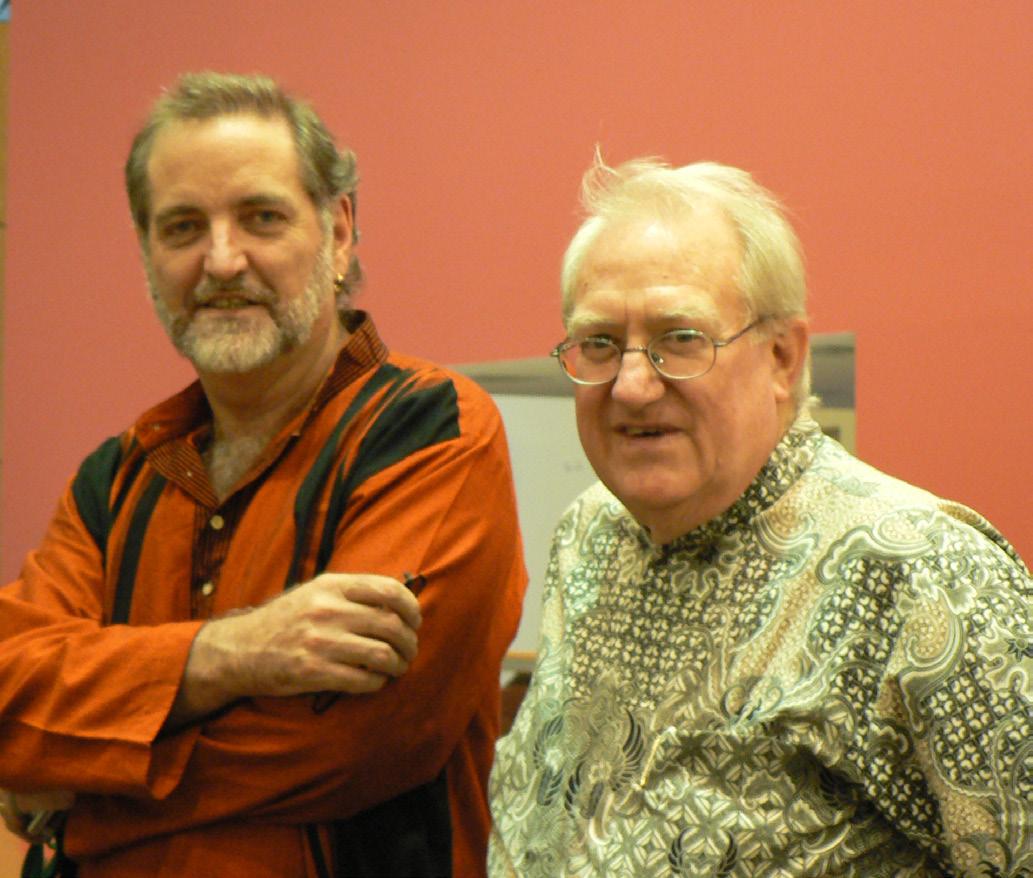
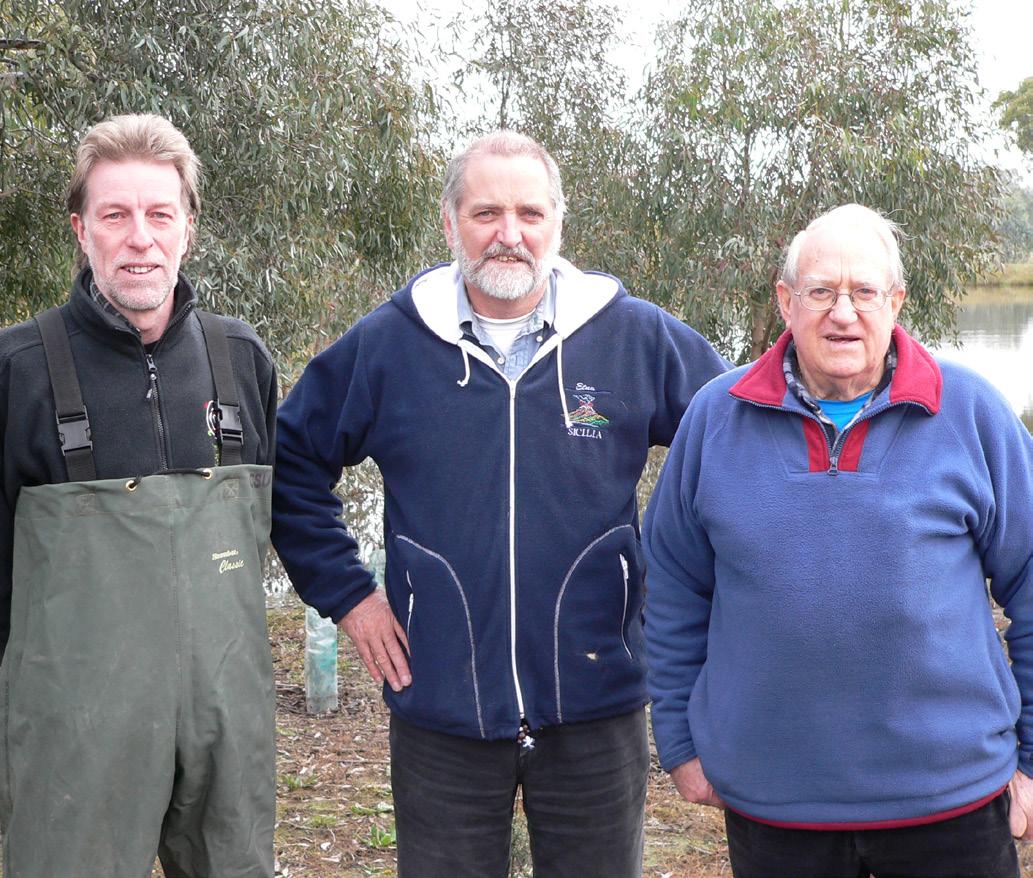
176 Wetland Science & Practice APRIL 2024
Max Finlayson, postdoc fellow with David at CSIRO 1980-83 and friend for a much longer period
IN MEMORIAM
Nick Davidson (left), Max Finlayson (middle), & David Mitchell (right), SWS International Fellows at the DS Mitchell constructed wetlands, Charles Sturt University, Albury, Australia
Max Finlayson (left) & David Mitchell (right), SWS International Fellows at the Society of Wetland Scientists conference, Cairns 2006
The World’s Most Troublesome Weed: Water Hyacinth and the Development of Wetland Science
Arnold van der Valk1
ABSTRACT
Water Hyacinth (Eichhornia crassipes (Mart.) Solms) is a large free-floating plant (up to 1 m tall) that can become established from seed and vegetative fragments. Vegetative growth is by stolons, creating floating mats of interconnected plants. Originally from South America, it reached the United States in the 1880s and, by the 1890s, had become a severe problem in Florida rivers. When large floating mats of Water Hyacinth began interfering with steamboat navigation on the St. Johns River and other rivers, various control measures were investigated to destroy or remove it, including mechanical harvesting, primitive herbicides, and physical barriers (booms). None proved completely effective. None of the numerous attempts to turn Water Hyacinth into salable commodities has been commercially viable. The lack of any permanent solution to Water Hyacinth infestations forced local governments in Florida to hire staff
to deal with infestations in their jurisdictions. Eventually, the number of people working on Water Hyacinth control increased significantly, resulting in the establishment of the Hyacinth Control Society in 1961 to facilitate the exchange of information on how best to manage it. This Society was the first American professional society whose members were dedicated to protecting and managing wetlands.
INTRODUCTION
Scientists working in many disciplines (botany, zoology, wildlife biology, ecology, etc.) have contributed to the development of wetland science. At the same time, non-scientists also influenced its development, including businessmen and philanthropists, a newspaper editorial cartoonist, politicians, and a landscape architect (see numerous articles by van der Valk listed in References). Likewise, many organizations have also played an important role, including Ducks Unlimited, the Delta Waterfowl Research Station, and federal and state/provincial wildlife agencies. Besides individuals and institutions, another major factor, environmental disasters, shaped the development of wetland science. The most important were the rapid decline of waterfowl populations during the late 19th and early 20th centuries, wetland drainage, and the spread of invasive aquatic weeds. 1

Wetland Science & Practice APRIL 2024 177 ARTICLES
Professor Emeritus, Ecology, Evolution, and Organismal Biology, Iowa State University, Ames, IA 50011; email: valk@iastate.edu
Figure 1. Global distribution of Water Hyacinth. Native distribution in purple. Introduced in beige. (Source: UNEP 2013)
The spread of aquatic weeds worldwide (Holm et al. 1969; Murphy 1988) has caused massive problems in lakes and rivers by disrupting navigation, recreational uses, and water extraction for public water systems, industrial uses, and agriculture. Since the impacts of aquatic weed infestations were often local, this resulted in establishing local (county, municipal) government agencies dedicated to managing aquatic weeds. Eventually, this led to establishing a professional society in the United States to serve aquatic weed managers. It is the impact of one of these aquatic weeds, Eichhornia crassipes (Mart.) Solms, commonly called Water Hyacinth, on the development of wetland science that I examine in this paper.
Water Hyacinth was one of the earliest and most troublesome aquatic weeds to become established in the United States. Its native range was tropical South America (Figure 1). It eventually spread throughout the tropics and subtropics around the globe (Gopal 1987). Wherever it became established, Water Hyacinth negatively impacted navigation, irrigated agriculture, recreation, local hydrology, and public health. Thus, Water Hyacinth infestations called for significant efforts by local, state, and federal governments to eradicate or manage it. Consequently, Water Hyacinth had a major effect on the development of wetland science by creating numerous positions for people working on its management. In the United States, it also resulted in the establishment of a professional society of Water Hyacinth managers, the Hyacinth Control Society (now the Aquatic Plant Management Society), that eventually became an international organization.
In this paper, I focus on the establishment, spread, impact, and control of Water Hyacinth in the southeastern United States in the late 19th and early 20th centuries. Iqbal (2009) provides an interesting account of how the colonial government of Bengal, now mostly Bangladesh, attempted to deal with Water Hyacinth infestations in British India. For a more international perspective on the impact of Water Hyacinth, see Holm et al. (1969), Barrett (1989), and UNEP (2013).
THE BIOLOGY OF WATER HYACINTH
The most widely used scientific name of Water Hyacinth is Eichhornia crassipes (Mart.) Solms 1883. It had previously been called Piaropus crassipes (Mart.) Raf. 1837. However, because of precedence, many contemporary taxonomists prefer Pontederia crassipes Mart. 1823. There have also been numerous synonyms that are no longer considered valid. Water Hyacinth belongs to the Monocot family Pontederiaceae Kunth.
This species probably originated in the Amazon basin and, before 1800, was confined to tropical and subtropical South America. Even today, it is restricted to tropical, subtropical, and warm temperate climates because it cannot

survive cold weather. Water Hyacinth had spread to Central America and the Caribbean by the end of the 19th Century. Today, it is found in South America, North America, Africa, Europe, Asia, and Oceania, including Australia (Figure 1). Each plant is a floating rosette of vertical leaves arranged spirally and separated by short internodes (Figure 2). Each leaf consists of a petiole, often swollen at the base, and a round to oval blade up to 15 cm wide. The swollen petioles enable it to float. Plants are typically 50 to 70 cm tall but can reach 100 cm. At the base of each leaf, roots develop that can form long, dense masses. Horizontal stolons, from which daughter plants develop, arise from axillary buds. As a result of this vegetative reproduction, large floating mats or islands of inter-connected plants can rapidly develop.
178 Wetland Science & Practice APRIL 2024
Figure 2. Eichhornia crassipes (Water Hyacinth). (Source: Courtesy of the Center for Aquatic and Invasive Plants, Institute of Food and Agricultural Sciences, University of Florida)
Water Hyacinth’s inflorescence is a spike up to 50 cm high (Figure 3). Each spike has 8-15 sessile flowers. The flowers have a perianth tube about 1.5 cm long terminated by six lilac or purple lobes up to 4 cm long. When the inflorescence has fully emerged, its flowers begin to open. After fertilization, the peduncle with its immature seed capsules starts to bend down and eventually becomes submerged. Each seed capsule matures underwater and can contain up to 450 tiny seeds.
Water Hyacinth flowers are tristylous and have six stamens and one style (Barret 1989). These are arranged in three possible configurations: a short style and medium and long stamens, a medium style with short and long stamens, or a long style with short and medium stamens. The medium-style form is common in most infested areas in North America. The different style-stamen forms are sexually compatible, and pollination, often by wind, results in an excellent seed set.
Seeds are released underwater from the mature capsules. The seeds can germinate immediately under suitable conditions but can remain dormant for years under unfavorable conditions. Seed germination requires aerobic conditions and alternating temperatures. Consequently, Water Hyacinth populations are established from seed mostly on exposed mud after falling water levels. These seedlings are rooted initially in the mud but become free-floating as water levels rise. Seedlings develop stolons; thus, large floating Water Hyacinth populations can become established rapidly.
More detailed information about the biology of Water Hyacinth can be found in Penfound and Earle (1948), Gopal and Sharma (1981), Gopal (1987), and Barrett (1989).
INFESTATION
By the late 19th and early 20th centuries, Water Hyacinth had become established in the southern United States, with the first infestations reported in Louisiana and Florida. At first, there was some confusion about what was causing the reported problems. “There has been a statement recently going the rounds of the daily press to the effect that the hyacinth has run wild on the rivers and other inland waters of Florida, covering the surface with a solid mass of vegetation and sending their roots eight feet through the water to the muddy bottom. It is expressly implied that this is the hyacinth par excellence, the bulbous plant so prized for its fragrant trusses [sic] of bloom on our lawns in early spring. As a matter of fact, this is far from the truth. The plant in question is the so-called Water Hyacinth (Piaropus crassipes), a member of the pickerel-weed family, and not even remotely related to the true hyacinth, which is, of course, a member of the lily family (Knowlton 1903).”
How did Water Hyacinth get to Florida? The culprit, according to Knowlton (1903), was Mr. Fuller. “It [Water Hyacinth] is a native of India and was introduced into Flor-

ida by a Mr. Fuller, who imported the plants about fifteen years ago and had them growing in a lake on his estate near Palatka. The plants increased so rapidly that to rid himself of the superabundance he threw the surplus into the St. Johns River. They increased with such astonishing rapidity that they finally covered the surface for miles, impeding navigation and otherwise causing alarm, but they disappeared as suddenly as they came.” Knowlton was mistaken about Water Hyacinth being a native of India, although it was first reported in India in the 1890s (Iqbal 2009). “… the hyacinth was brought to Calcutta Botanic Garden from Brazil in the 1890s and at a later date some ladies, being attracted by its flower, collected and transplanted these weeds to their gardens in Dhaka (Iqbal 2009).” In reality, Water Hyacinths probably were brought to Florida from Louisiana.
As an aside, the most incredible account of the introduction and spread of Water Hyacinth anywhere in the world comes from India. “The rapid spread of this weed in Bengal at the outset of the First World War has also been credited to the Germans, who wanted to weaken the British by killing their Indian subjects, hence it became known as the German pana or German weed (Iqbal 2009).” Biological warfare?
Wetland Science & Practice APRIL 2024 179
Figure 3. Flowering Water Hyacinth. (Photo by H. Zell; courtesy of Wikimedia Commons)
The earliest date that Water Hyacinth has been reported in the United States is 1884. This origin story is found in Klorer (1909): “It [Water Hyacinth] made its appearance here [Louisiana] at the time of the Cotton Centennial Exposition in 1884, being shown then as an exotic plant which readily made friends on account of its beautiful bloom and the little difficulty experienced in growing it. Some of the plants from New Orleans were taken to the surrounding parishes and cultivated in ponds and gardens as admirable aquatic specimens. It is supposed that they rapidly outgrew the limited water surface given to them and that they were cast out or probably dumped into some nearby stream and thus found conditions favorable to growing undisturbed.” Klorer’s account raises the question, how did Water Hyacinth get to Louisiana?
The most likely answer is that horticulturalists introduced it. Growing aquatic plants in aquaria (Hibberd 1856) and water gardens (Tricker 1897) was popular in the 19th Century. Exotic aquatic plants were imported and sold at local garden centers that stocked plants for water gardens. How easily Water Hyacinth could be obtained is described in a short article published in 1895 in The Journal of Education: “That the development of the aesthetic element in the child’s nature is an essential part of his education is no longer questioned; and to this end, what simpler or more effectual means than the cultivation of a few flowers in the schoolroom? An admirable one for this purpose is the water hyacinth, which may be readily obtained of any leading florist for a trifling sum, providing no patron of the school has an extra root to give or throw away (Putnam 1895).” More sensible advice was published two years later in The Water Garden: “Advisable not to plant [Water Hyacinth] where it will not be winter-killed, as it will block navigable streams, and be a source of much trouble and expense to eradicate (Tricker 1897).”
Although the negative impacts of Water Hyacinth were first recorded in Louisiana and Florida in the 1890s, they were soon felt in Queensland, Australia in 1895, in South Africa in 1900, in Vietnam in 1908, and in Myanmar (Burma) in about 1913 (Gopal 1987, Iqbal 2009). Penfound and Earle (1948) summarized the damage caused by water hyacinth infestations: “… by (1) Obstructing navigation, (2) Impeding drainage, (3) Destroying wildlife resources, (4) Reducing out-of-doors recreation, and (5) Constituting a hazard to life (Penfound and Earle 1948).”
THE ST. JOHNS RIVER INFESTATION
The most dramatic and widely reported early water hyacinth infestation in the United States was in the St. Johns River in Florida (Lucas 1897, Webber 1897, Akroydd 1899, Curtiss 1900, Hope 1902). “Another case of obstruction by aquatic vegetation in America is found in Florida, U.S., North America, where — originally introduced from tropical South America for its beauty as a flowering plant — the
so-called Water Hyacinth has become naturalized, and has increased to such an enormous extent in the St. Johns River as to cause serious apprehension that navigation may be altogether closed. …. small tributary creeks of the St. Johns River are entirely covered. The main channel of the river remains clear unless masses of the plants become so packed together as to produce a block. In most places the hyacinth grows to some extent on the muddy shores of the rivers and lakes, and the stolons become so entangled that the plants whose roots penetrate the soil serve to moor large floating masses to the shore. Masses get loose and are blown by the wind, even 25 miles up stream, and there form solid masses. Other large masses are carried by the current down to the sea.… Mr. Webber … gives a graphic account of the damage caused by obstruction to the rafts in which timber is brought down the river, and to fishing with nets, and an illustration … shows at once the great width of the St. Johns and the extent to which it is in places covered by Eichhornia, with large river steamers imbedded in it. Masses of the plant floating down stream get banked up against the long low bridge which carries a railway across the river or estuary and act as a dam to the water. Another illustration shows how the weed, floating down stream, is diverted by booms into docks similarly constructed, whence it is taken on shore and used as manure. (Hope 1902).” Similar infestations occurred worldwide with similar or worse impacts (Holms et al. 1969).
As soon as it was recognized as a significant impediment to navigation, a “war” on Water Hyacinth was declared (Dabney 1921). Ways to destroy Water Hyacinth began to be investigated, with the federal government often footing the bills (Ward 1914). Early solutions included crushing the plants, booms to prevent their spread (Figure 5), spraying them with a chemical solution previously developed to kill terrestrial weeds, and a “hyacinth elevator.” Ward describes these pioneering efforts: “… a boat was equipped in New Orleans with rollers to crush the hyacinth and log booms to aid in gathering the plants. This apparatus worked very well in Louisiana. In 1900, spraying experiments were made with the Harvesta compound, made by the Harvesta Chemical Compounding Company of New Orleans. This gave satisfactory results at a much lower cost than the crushing method.” However, the Harvesta chemical compound, which contained cyanide, proved to have unintended consequences. In Florida, Water Hyacinth was widely used as fodder for cattle. After Harvesta spraying, government authorities began to receive numerous complaints from farmers that sprayed Water Hyacinth was harmful to cattle. The River and Harbor Act of 1905 contained an appropriation for removing Water Hyacinth in the Florida waters, provided that no chemical be used that was harmful to cattle. “Accordingly, in Florida the method was adopted of breaking up the packs and pushing them into the current (Ward 1914).” Florida also experimented with
180 Wetland Science & Practice APRIL 2024
the “hyacinth elevator.” A hyacinth elevator consisted of a catamaran scow, equipped with an inclined conveyor belt powered by a gasoline engine. It was the first aquatic weed harvester.
Ward (1914) summarized the various attempts to control Water Hyacinth: “There appears to be no method that will completely remove water hyacinth at a reasonable cost, although experiments have been made with every known chemical. Bodily removal is, of course, the most effective measure. This can be easily done with small areas. Spraying is the best method for large areas, but where the plant is eaten by cattle a mechanical device must be adopted like the hyacinth elevator that is used in the Florida waters. Good results can be obtained by closing creeks, bayous, and sloughs [with booms] (Figure 4) to prevent the movement of the plant to other waters.” Until the advent of biological controls later in the 20th Century, the control methods described by Ward were the only ones for those charged with managing Water Hyacinth.
CURSE OR CROP
Not everyone considered Water Hyacinth infestations a problem to be solved by eradication. The glass-half-full optimists saw it as a resource to be exploited and quickly began exploring ways to turn this prolific plant into a money-making product (Bates and Hentges 1976; Pirie 1960). In many areas, feeding it to livestock (cattle, pigs) or using it as a soil supplement or mulch was successful (Sharma 1971; Wolverton and McDonald 1979; Gopal and Sharma 1981). See also Little’s (1979) Handbook of Utilization of Aquatic Plants. A Review of World Literature for many more examples.
One of the primary problems facing would-be entrepreneurs is that Water Hyacinth is 90 to 95% water. Removing this water to produce a stable product is expensive. For example, Nolan and Kirmse (1974): “… [our] research study was part of an overall investigation of possible salable products from waterhyacinth plants harvested from the lakes and streams in Florida (Nolan and Kirmse 1974).” They did various studies to optimize the extraction of fibers suitable for paper-making from Water Hyacinth plants. Based on the whole plant, fiber yields were extremely low. Because fiber yields were so low, Water Hyacinth did not have salable value for the paper industry. Nolan and Kirmse tried to make the best out of their negative results. They ended their paper, “Even though this research has proved that commercially acceptable paper pulps cannot be made from waterhyacinths, publication of the procedures and the results obtained will, it is hoped, prevent others from undertaking an expensive research program to develop the use of waterhyacinth plants as a raw material for the paper industry.”
Determining if Water Hyacinths can be used to make paper represents a sensible approach to finding a possible salable product. Not all proposals to exploit Water Hyacinth


Wetland Science & Practice APRIL 2024 181
Figure 4. Deflection booms designed to remove Water Hyacinth from flowing water. (Source: Webber 1897)
Figure 5. A boom to prevent Water Hyacinth in tributary streams from entering the main river channel. (Source: A Photo History of Florida Steamboats and Water Hyacinth Management; courtesy of the Center for Aquatic and Invasive Plants, Institute of Food and Agricultural Sciences, University of Florida, and the Florida Fish and Wildlife Commission)
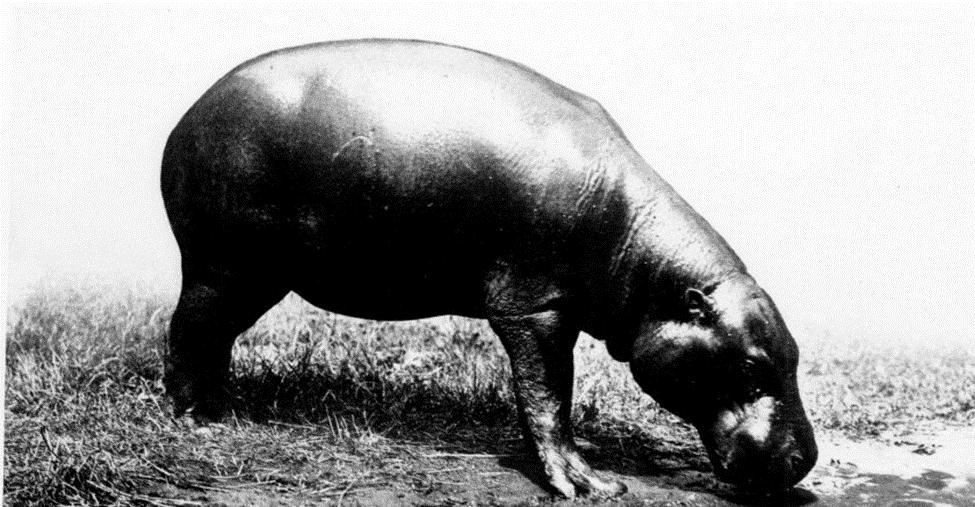
commercially were so rational. In 1914, The Journal of Heredity published arguably the most farfetched paper on turning aquatic weeds into cash. Its full title was “MEAT PRODUCTION IN SWAMPS: Introduction of Pigmy Hippopotamus Offers Opportunity for Utilization of Large Areas in Southern States to Produce Excellent Meat at Low Cost — Difficulties of Securing Breeding Stock at Last Overcome.” The paper points out that the Southern states have over 10,000 square miles of wetlands. “… If properly seeded to water hyacinth and other aquatic plants, this vast region would be capable of producing a million tons of [pigmy hippo] meat per annum, worth $100,000,000 (P. B. P. 1914).” Its author, P. B. P., goes on to say that “the flesh … is highly esteemed, and when salted and cured, is known in the Cape of Good Hope [South Africa] as ZeeKoe Speck (lake-cow bacon).” The frontispiece for the issue containing this 1914 paper is a picture of a pigmy hippo (Figure 6). The paper ends more soberly: “At present the cost of breeding animals is prohibitive, the New York Zoological Society having paid $12,000 for three ….”
Other attempts to find commercially viable uses for Water Hyacinth also have banked on its high productivity, e.g., for removing pollutants from water. Although Water Hyacinth has been shown repeatedly to be able to remove pollutants from contaminated water, what to do with the contaminated plants remains a problem. Biogas and biofuel production is possible, but this has never been done on more than a pilot scale. So far, no industrial-scale uses of Water Hyacinth have been developed.
THE HYACINTH CONTROL SOCIETY
“The introduction and rapid spread of the water-hyacinth (Piaropus crassipes) in some of the rivers of Florida, and the consequent injury to navigation, fishing, lumbering, and other industries, attracted considerable attention a few years ago, but since that time the plants are said to have so decreased in numbers as to be no longer troublesome (Harper 1903).” Although the scourge of Water Hyacinth in north Florida had diminished by the start of the 20th Century, its impacts further south in the state had just begun. During the

first half of the 20th Century, Water Hyacinth was a serious aquatic weed problem in South Florida, and Water Hyacinth infestations (Figure 7) continued to interfere with recreational and commercial activities in rivers and lakes. This forced local governments to adopt measures to manage it. As more and more local government employees became involved in water hyacinth management, interest arose in establishing a professional organization to serve their needs. In 1961, the Hyacinth Control Society was incorporated precisely so that managers in Florida could share information on their efforts to control Water Hyacinth. The Society was one of the first formed to manage an invasive species in natural areas. Although it saw its mission allied more with weed science than wetland science, the Hyacinth Control Society was also one of the first organizations formed to protect and manage native wetlands in some sense.
According to the history of the Society on its website, its founding fathers, i.e., the subscribers to the Society’s Incorporation papers, were all from Florida, mostly South Florida. T. W. Miller, the Society’s first president, was the Director of the Lee County Hyacinth Control District. A. S. Chipley was a member of the Board of the Lee County Mosquito Control District, as was William Dryden. Thomas O. Fultz was the Mosquito Control Director of Polk County. Edward L. Seabrook was the Director of the Palm Beach County Mosquito Control District. Herbert J. Friedman
a businessman in Tampa,
several mosquito and hyacinth
programs. D. E. Seaman
Department
Agriculture
Ft. Lau-
control of aquatic plants. Two things
evident from the affiliations of the “founding fathers”: (1) the Society was initially established for and
182 Wetland Science & Practice APRIL 2024
was
FL, who had served on
control
worked for the U.S.
of
in
derdale on the biology and
are
Figure 6. Pigmy hippo. (Source: The Journal of Heredity Volume 5, Number 21; 1914)
Figure 7. Hickey Creek, a tributary of the Caloosahatchee River in southwest Florida, was choked with Water Hyacinth in 1917. (Source: A Photo History of Florida Steamboats and Water Hyacinth Management; courtesy of the Center for Aquatic and Invasive Plants, Institute of Food and Agricultural Sciences, University of Florida, and the Florida Fish and Wildlife Commission)
governed by local government employees, and (2) Water Hyacinth control was closely linked to mosquito control. Because mosquitoes were vectors of human diseases like malaria, mosquito control was a significant public health problem in the southern United States (van der Valk 2022a). Thus, mosquito control was also an essential responsibility of Florida’s local governments, as it is today.
At first, the Society’s foci were (1) determining the extent of the Water Hyacinth problem and (2) developing the infrastructure needed to plan and fund control projects. Besides having an annual meeting, in 1962, the Society began to publish its Hyacinth Control Journal. During the first decade of its publication, its papers dealt increasingly with controlling aquatic weeds with herbicides. With the establishment of other aquatic weeds, especially hydrilla (Hydrilla verticillata (L. f.) Royle), in Florida, the Society’s mission was broadened to include their management.
After years of debate, the Hyacinth Control Society changed its name in 1976 to the Aquatic Plant Management Society. Accordingly, it re-named its journal the Journal of Aquatic Plant Management. By the early 1970s, the everlengthening list of aquatic weeds in Florida now included Eurasian watermilfoil (Myriophyllum spicatum L.), which was also a problem in wetlands outside of Florida. Gradually, the Society began attracting members from outside the state, and eventually, regional chapters were established. Since the 1980s, the Society has continued to expand in the United States and internationally. According to its website, the Society’s objectives are “to promote the management of nuisance aquatic plants, provide for the scientific advancement of members of the society, encourage scientific research, promote university scholarship, and stir public interest in the aquatic plant science discipline.”
The Hyacinth Control Society was the first professional organization established by and for people working on wetland management in the United States. Compared to the Society of Wetland Scientists’ mission, its narrow focus is understandable. The Hyacinth Control Society was founded to serve government employees working on aquatic weed management. Nevertheless, the Hyacinth Control Society provided professional support and professional identity for a subset of managers and, eventually, scientists working to protect American wetlands. Their essential work allowed the public to use wetlands for recreation (boating, fishing, hunting, etc.), which helped to raise public awareness of the societal importance of wetlands and, thus, their preservation.
SUMMARY
Water Hyacinth, indigenous to tropical and subtropical South America, reached the United States in the 1880s and, by the 1890s, had become a significant problem in Florida rivers, most notably the St. Johns River. Because it was an attractive plant highly prized by water gardeners, it rapidly spread throughout the southeastern states. Water Hyacinth
is a large free-floating plant (50 to 70 cm tall) that can become established from seed and vegetative fragments. Vegetative reproduction is by stolons, which can rapidly create large floating mats of interconnected plants.
When floating mats of Water Hyacinth began to interfere with steamboats transporting goods and people on the St. Johns River and other navigable rivers, the federal government started funding projects to control it. Various control measures were tried, including mechanical harvesting, primitive herbicides, and physical barriers (booms). None proved completely effective, and the primitive herbicides caused serious collateral damage. Many ways to turn Water Hyacinth into a salable commodity, from making paper to raising pigmy hippos for meat, were explored. Still, none proved to be viable on a commercial scale.
The lack of a permanent solution to Water Hyacinth infestations required local Florida governments to hire staff to deal with them in their jurisdictions. Over time, the number of people working on Water Hyacinth control increased rapidly, and this resulted in the establishment of the Hyacinth Control Society in 1961 to facilitate the exchange of information about the effectiveness of various control measures. In 1962, the Hyacinth Control Society began publishing a journal. The Hyacinth Control Society was among the first, if not the first, organization dedicated to protecting the integrity of America’s natural wetlands.
REFERENCES
Akroydd, W. 1899. A river choked with Hyacinths. The Windsor Magazine: An Illustrated Monthly for Men and Women London, July, pp 153-157.
Barrett, S.C.H. 1989. Waterweed invasions. Scientific American 261: 9097. doi:10.1038/scientificamerican1089-90
Bates, R.P. and J. F. Hentges. 1976. Aquatic weeds—eradicate or cultivate? Economic Botany 30: 39-50. doi.org/10.1007/bf02866783
Curtiss, A.H. 1900. The Water Hyacinth in Florida. The Plant World 3: 38-40. Jstor.org/stable/43805081
Dabney, T.E. 1921. Fighting the Water Hyacinth. Scientific American 125:260. doi:10.1038/scientificamerican10081921-260
Gopal, B. 1987. Water Hyacinth. Elsevier, New York, NY.
Gopal, B. and K.P. Sharma. 1981. Water-hyacinth (Eichhornia crassipes): the most troublesome weed of the world. Hindasia, Delhi, India.
Gopal, B. and K.P. Sharma. 1981. Water-hyacinth (Eichhornia crassipes): the most troublesome weed of the world. Hindasia, Delhi, India.
Harper, R.M. 1903. The water-hyacinth in Georgia. Plant World 6:164165. jstor.org/stable/43476141
Hibberd, S. 1856. The Book of the Aquarium and Water Cabinet, Or, Practical Instructions on the Formation, Stocking, and Management, in All Seasons, of Collections of Fresh Water and Marine Life. Groombridge & Sons, London, England.
Holm, L.G., L.W. Weldon and R.D. Blackburn. 1969. Aquatic Weeds. Science 166: 699-709. jstor.org/stable/1727776
Hope, C.W. 1902. The ‘Sadd’ of the Upper Nile: its botany compared with that of similar obstructions in Bengal and American waters. Annals of Botany 16: 495-516. jstor.org/stable/43235187
Iqbal, I. 2009. Fighting with a weed: Water Hyacinth and the State in colonial Bengal, c. 1910-1947. Environment and History 15: 35-59. jstor. org/stable/20723705
Wetland Science & Practice APRIL 2024 183
Klorer, J. 1909. The water hyacinth problem. Journal of the Association of Engineering Societies 42: 42-48.
Knowlton, F.H. 1903. The home garden and greenhouse. The Plant World 6: 19-22. jstor.org/stable/43476106
Little, E.C.S. 1979. Handbook of Utilization of Aquatic Plants A Review of World Literature. F.A.O. Fisheries Technical Paper No. 187. F.A.O., Rome, Italy.
Lucas, F.A. 1897. Biological Society of Washington, 276th Meeting, Saturday, April 24. Science 5: 810-811. doi.org/10.1126/science.5.125.810.b
Murphy, K.J. 1988. Aquatic weed problems and their management: a review I. The worldwide scale of the aquatic weed problem. Crop Protection 7: 232-248. doi.org/10.1016/0261-2194(88)90044-0
Nolan, W.J. and D.W. Kirmse. 1974. The paper making properties of Water Hyacinth. Hyacinth Control Journal 12: 90-97.
Penfound, W.T. and T.T. Earle. 1948. The Biology of the Water Hyacinth. Ecological Monographs 18: 447-472. doi.org/10.2307/1948585
Pirie, N.W. 1960. Water Hyacinth: a curse or a crop? Nature 185: 116116. https://doi.org/10.1038/185116a0
P. B. P. 1914. Meat production in swamps: Introduction of Pigmy Hippopotamus offers opportunity for utilization of large areas in Southern States to produce excellent meat at low cost—Difficulties of securing breeding stock at last overcome. Journal of Heredity 5: 34-37. doi. org/10.1093/jhered/5.1.34
Putnam, B.L. 1895. The Water Hyacinth. The Journal of Education 42:279.
Sharma, A. 1971. Eradication and utilization of Water Hyacinth–a review. Current Science 40: 51-55. jstor.org/stable/24074566
Tricker, W. 1897. The Water Garden: Embracing the Construction of Ponds, Adapting Natural Streams, Planting, Hybridizing, Seed Saving, Propagation, Building an Aquatic House, Wintering, Correct Designing and Planting of Banks and Margins, Together with Cultural Directions for All Ornamental Aquatics. A. T. De La Mare Printing and Publishing Company, New York, NY.
UNEP 2013. Water Hyacinth -- Can its aggressive invasion be controlled? UNEP Global Environmental Alert Service. April 2013. Unpaginated. wedocs.unep.org/20.500.11822/8483
van der Valk, A.G. 2017. Antecedent wetland ecologists - German and Austrian in the Ninetieth Century. Wetland Science and Practice 34: 112117. doi.org/10.1672/UCRT083-259
van der Valk, A.G. 2018a. Stephen A. Forbes, Antecedent Wetland Ecologist? Wetland Science and Practice 35: 18-24. Doi.org/10.1672/ UCRT083-256
van der Valk, A.G. 2018b. Assisting Nature: Ducks, “Ding” and D.U. Wetland Science and Practice 35: 60-67. doi.org/10.1672/UCRT083-253
van der Valk, A.G. 2020. Howard T. Odum and wetland ecology. Wetland Science and Practice 37: 26-32. doi.org/10.1672/UCRT083-220
van der Valk, A.G. 2022a. Naturalistic control: W. T. Penfound, T. F. Hall, and A. D. Hess and malaria control in Tennessee Valley Authority Reservoirs. Wetland Science and Practice 40: 128-134. doi.org/10.1672/ UCRT083-61
van der Valk, A.G. 2022b. From wasteland to tourist attraction: The creation of Everglades National Park. Wetland Science and Practice 40: 293-301. doi.org/10.1672/UCRT083-57
van der Valk, A.G. 2023a Beginnings of Wetland Science in Britain: Agnes Arber and William H. Pearsall. Wetland Science and Practice 41: 10-18. doi.org/10.1672/UCRT083-55
van der Valk, A.G. 2023b. Men of the Marshes: Paul L. Errington and H. Albert Hochbaum. Wetland Science and Practice 51: 43-50. doi. org/10.1672/UCRT083-50
Ward, R.T. 1914. Notes Upon the Water Hyacinth. Professional Memoirs, Corps of Engineers, United States Army, and Engineer Department at Large 6:644-648. jstor.org/stable/44580089
Webber, H.J. 1897. Water Hyacinth, and its relation to navigation in Florida. U.S. Dept. of Agriculture, Division of Botany, Washington, DC. lccn.loc.gov/agr09000505
Wolverton, B.C. and R.C. McDonald. 1979. The Water Hyacinth: from prolific pest to potential provider. Ambio 8: 2-9. jstor.org/stable/4312402
184 Wetland Science & Practice APRIL 2024
Rights of Nature in Wetlands –Transformative Change for Securing the Future of Wetlands Through Effective Restoration
Gillian Davies1,2, Max Finlayson3,4, Matthew Simpson5,6, William Moomaw7,8, and Siobhan Fennessy9
THE RIGHTS OF NATURE IN WETLANDS
Indigenous Peoples, local communities and non-profit organizations have been leading a growing global “Rights of Nature” movement that reconsiders the human-Nature relationship and returns to a recognition of Nature’s living beingness and inherent rights (Kaufman and Martin 2021; https://celdf.org/rights-of-nature/ accessed 21 October 2023). These perspectives have been shared by many cultures and societies throughout history and continue to be the foundation beliefs of many communities. This alternative attitude moves the human-Nature relationship from one of exploitation, depletion, degradation and loss to one based on relational values such as reciprocity, gratitude, and respect. For the populations of modern nation states, this perspective constitutes a paradigm shift that may lead to greater success in achieving conservation goals and support for restoration, regeneration, and re-wilding initiatives that might implement the recently agreed Global Biodiversity Framework (https://www.cbd.int/gbf/ accessed 20 October 2023).
Consistent with the Rights of Nature paradigm a group of wetland and climate scientists, policy specialists, and attorneys has proposed a Universal Declaration of the Rights of Wetlands, that outlines a case for the Declaration and proposes eight inherent rights for wetlands (Davies et al. 2021). The Declaration can be read in full on the Rights of Wetlands website https://www.rightsofwetlands.org/ accessed 20 October 2023). The eight rights are listed below and shown in Figure 1:
1. The right to exist
2. The right to their ecologically determined location in the landscape
3. The right to natural, connected and sustainable hydrological regimes
4. The right to ecologically sustainable climatic conditions
5. The right to have naturally occurring biodiversity, free of introduced or invasive species that disrupt their ecological integrity
6. The right to integrity of structure, function, evolutionary processes and the ability to fulfill natural ecological roles in the Earth’s processes
7. The right to be free from pollution and degradation
8. The right to regeneration and restoration
In July 2023, the Society for Ecological Restoration (SER) Executive Director, Bethanie Walder, joined SWS wetland scientists Matt Simpson and Gillian Davies as speakers for a Society for Ecological Restoration (SER) webinar titled, Why and How Implementing Rights of Wetlands Can Enhance Restoration and More. This webinar can be viewed on the SER webinar library website page: https://www.ser.org/news/news.asp?id=646823 (accessed 20 October 2023). In September, a guide to operationalizing the Rights of Wetlands was presented and released at the SER2023 World Conference in Darwin, Australia. This guide is available on the Rights of Wetlands website: https://www.rightsofwetlands.org/howtodeliver (accessed 20 October 2023). A three-year project, funded by the UK government’s Darwin Initiative, that examines how Rights of Wetlands is being and can be implemented by communities and governments in Bolivia, Ecuador, Guyana, Kenya and Sri Lanka, also commenced in 2023 and forms part of the United Nations Water Action Agenda: https://sdgs. un.org/partnerships/operationalization-universal-declaration-rights-wetlands (accessed 20 October 2023).
The Rights of Wetlands proposal has been shared globally with the Convention on Wetlands (Ramsar Convention) Signatory Countries, non-governmental organizations, Indigenous Peoples and Local Communities, and others, and thus far has been endorsed by 28 organizations, including the Society of Wetland Scientists, Wetlands International, Wildfowl and Wetlands Trust, the Community Environmental Legal Defense Fund, and the Society for Ecological Restoration. Discussions with individuals and organizations have refined the concept by incorporating cultural and geographical differences to reflect the general principles that wetlands have an inalienable right to exist, to have a
1 Global Development and Environment Institute, Tufts University, Medford, Massachusetts, USA
2 BSC Group, Inc., Worcester, Massachusetts, USA
3 School of Biological, Earth and Environmental Sciences, Faculty of Science, University of New South Wales (Sydney, Australia)
4 Gulbali Institute for Agriculture, Water & Environment, Charles Sturt University, Albury, Australia
5 35percent, Stroud, Gloucestershire, UK
6 Cobra Collective, Egham, Surrey, UK
7 Center for International Environment and Resource Policy, Fletcher School, Tufts University
8 Woodwell Climate Research Center Massachusetts USA
9 Departments of Biology and Environmental Studies, Kenyon College, Gambier, OH USA
Wetland Science & Practice APRIL 2024 185

place to exist, to participate in Earth’s natural processes, and humans have a shared responsibility to respect this. The Declaration provides talking points and a signal that it could be useful to reframe the conservation and wise/sustainable use ethics of the Ramsar Convention to provide an ethical and legal paradigm recognizing the legal rights and living beingness of wetlands. Given past loss (Fluet-Chouinard et al. 2023) and degradation of wetlands (Ramsar Convention on Wetlands 2018) the right to regeneration and restoration is an important part of the proposed Declaration and also is important to the efforts by the Convention on Wetlands to justify and implement these practices. The Convention includes guidance for wetland restoration with the following principles enumerated (as adapted by Herb and Finlayson 2023).
Simplified Convention on Wetlands Restoration Principles
• Clear understanding and statement of goals, objectives, and performance standards
• Consideration of natural processes and existing conditions
• Watershed (catchment) approach
• Stakeholder engagement
• Self-maintenance
• Adaptive management
In an appraisal of the guidance provided by the Convention, Herb and Finlayson (2023) emphasized the benefits that can accrue and state that “Engaging the public and increasing general knowledge of wetlands …… is essential for maintaining global wetland health. It will lead to more resources being allocated to wetland restoration, as well as foster avoidance and minimization of wetland impacts in the future.” Incorporating specific rights of wetlands will not only help reduce the need for restoration by reducing wetland degradation but given that these rights are closely associated with the ethics of communities closely connected to wetlands, it will also help confirm specific goals for the success of restoration efforts – goals that express the human connections with wetlands and confirm their rights to exist. Recognizing Rights of Wetlands also fosters reciprocity, in which humans can give back to wetlands in return for all the services they provide especially in the form of care (wise/sustainable use) and restoration following the damage they have done (providing the means for healing). We do not see this as differing from the Convention’s support for maintaining the ecological character of all wetlands – obligating the maintenance of the biodiversity, ecological processes, and ecosystem services that characterize a wetland is very much an expression of the right of that wetland to exist, and to be restored where that obligation has not been met.
186 Wetland Science & Practice APRIL 2024
Figure 1. The rights of wetlands (based on Society of Wetland Scientists Rights of Wetlands Initiative and Operationalization Working Groups 2023)


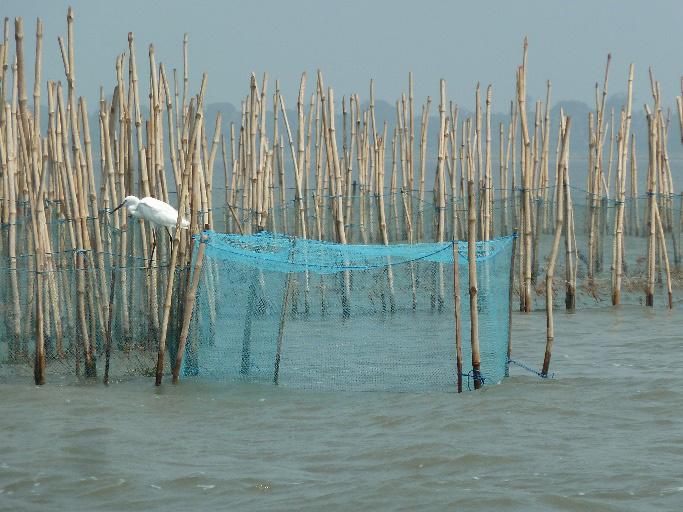

WHY DO WE NEED A PARADIGM SHIFT NOW?
It is now more than 50 years since the text of the Convention on Wetlands was agreed in the Iranian city of Ramsar (Stroud et al. 2022). The 2021 golden anniversary of the Convention was celebrated with the 14th conference of parties being held conjointly in Wuhan, China and Geneva, Switzerland in November 2022. This was an occasion for celebration, and also for reflection. The celebration includes the accession of 172 signatory nations, and the nomination of 2,471 Ramsar sites covering a surface area of 256,192,356 hectares (ca. 16.5% of global wetland area). However, it was not all good news since it as reported that many nations were not fulfilling their obligations to ensure the sustainable use of all wetlands, nor restoring those that had been degraded. Restoration is occurring in many places (see Figures 2–4), but is insufficient in comparison to the losses, and not necessarily fully successful (Herb and Finlayson 2023).
Wetland restoration has occurred in many sites in the United States (Figures 3 and 4) in response to wetlands being specifically mentioned under the Clean Water Act in 1980. In the decades that followed area-for area many restoration projects have been undertaken, but with inadequate regard for functional replacement (Herb and Finlayson 2023). In such cases while the right to restoration has been recognized, the further right to integrity of structure, function, etc. (see above) has not been satisfactorily addressed.
The Convention on Wetlands has now met formally on 14 occasions and passed more than 360 resolutions. Some of the resolutions have addressed administrative issues, with others addressing drivers of adverse change in wetlands, or providing guidance on inventory, assessment, monitoring and management approaches. A specific report is provided at each meeting on the status of Ramsar sites (wetlands listed as internationally important; for example, see Ramsar Convention on Wetlands 2022). The Contract-
Wetland Science & Practice APRIL 2024 187
Figure 2. Restoration efforts over several decades at Chilika Lagoon, India, including constructing a channel from the lagoon to the ocean (upper left) have successfully improved the ecological conditions and led to improvements in the biodiversity values including those for waterbirds (upper right), increased fish catches by local communities (lower left) and tourism as shown by this poster highlighting the resident population of Irrawaddy dolphins (lower right). (Photographs © CM Finlayson)



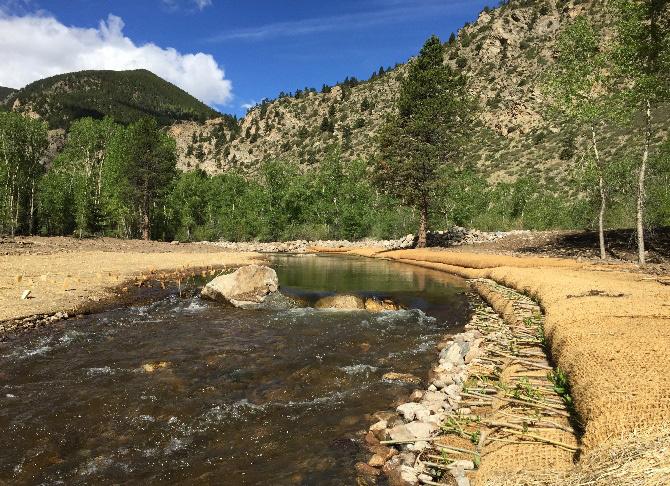
ing Parties to the Convention have reported many successful management efforts, but loss and degradation of wetlands continue, and much more restoration is needed. It has commonly been reported that 35% of the world’s wetlands have been lost since 1970 (Darrah et al. 2020), but without cautionary comments about the geographical variability in wetland loss and the assumptions made when extrapolating from the underlying analyses to an encompassing global statement. This is more so the case for the similarly widely used value of 87% loss of wetlands since 1700 reported by Davidson (2014) on the basis of a small data set – extrapolating to current estimates of the area of inland wetlands (12 x 106 km2) reveals that the area of inland wetlands in 1700 would have been around 92 x 106 km2, compared to a current global land area of 149 x 106 km2 (Finlayson et al. 2022). More recent analyses based on drainage records and modelling of land uses suggest a lower loss for inland (nontidal) wetlands of 20 to 35% since 1700 (Fluet-Chouinard
et al. 2023). The latter authors discuss the disparity between the various estimates including the use of data disproportionately from regions with high-loss regions. The overall conclusions remain much the same - we have lost a significant percentage of our wetlands, and the losses continue, and more restoration is needed. If the rates of loss are in fact less than previously estimated this in itself presents an opportunity to make the best use of our wetlands, prevent further loss, and to restore those that have been damaged.
Given the value of wetlands, even the lower rates of loss are alarming. Further global analyses have shown that human-caused climate destabilization poses an existential threat to existing wetlands, their species and ecosystem services, and to the communities who depend on their many ecosystem services (Moomaw et al. 2018; Finlayson and Gardner 2020). Reducing the impacts of climate destabilization on wetlands is an essential part of global efforts to ensure the future of biodiversity and ecosystem
188 Wetland Science & Practice APRIL 2024
Figure 3. Wetland restoration projects are underway in many parts of the world. Examples include revegetation and the removal of invasive weeds along the Murrumbidgee River in Australia (upper left), lake and marsh restoration in Tongli, China (upper right), community-based restoration projects, education and outreach initiatives in Tampa Bay in the United States (lower left) and river restoration, Colorado, United States (lower right). (Photographs: upper and lower left © CM Finlayson; upper right © R Woodward; lower right © M Simpson).

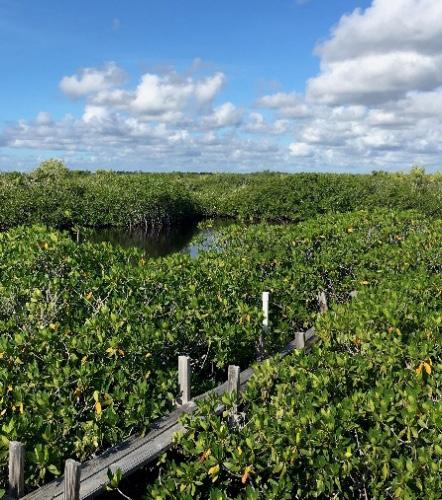


services (Moomaw et al. 2018). As outlined in the ‘warnings to humanity’ provided by world scientists, including for wetlands (Finlayson et al. 2018), the next few decades will determine our collective fate as we confront the global climate and biodiversity emergencies, exacerbated by degradation and loss of wetlands, and the consequent increasing need for their restoration.
The catch cry to halt and reverse the loss and degradation of wetlands was most prominently made at the 1992 Mediterranean wetland conference in the Italian city of Grado (Hollis 1992) and was subsequently incorporated into the Strategic Plan of the Ramsar Convention on Wetlands (Ramsar Convention on Wetlands 2015). However, efforts to halt and reverse the degradation and loss
of wetlands have not been sufficient despite the efforts of the parties to the Convention on Wetlands (Davidson et al. 2023). These failures herald a call for new approaches to complement the Convention and the international and national initiatives of the past 50 years. These approaches could include a reappraisal of the future fitness for purpose of the Convention and include a fundamental ethical and legal paradigm shift that recognizes the legal rights and living beingness of wetlands (Simpson et al. 2020; Fennessy et al. 2021).
Formal acceptance of a Declaration of the Rights of Wetlands could facilitate a fundamental shift in global efforts to ensure the conservation and wise/sustainable use of all wetlands. The latter is a fundamental feature of the
Wetland Science & Practice APRIL 2024 189
Figure 4. Wetland restoration has occurred in the United States over the past few decades with many areas being successfully restored on an areal basis, but not necessarily on a functional basis. This includes shrub/scrub wetland restored by removing fill and then translocating intact soil and vegetation blocks from a nearby wetland impact area in Massachusetts (upper left); a restored wet meadow in Massachusetts (upper right); system-wide restoration of mangroves in the Florida Everglades (lower left); and a wetland restored by breaking drain tile in the agricultural Midwest. (Photographs: top © G Davies; lower © MS Fennessy)
Convention on Wetlands. Our initial appraisal of the articles of the Convention and its formal resolutions suggests that the rights presented in the Declaration are implicit in the Convention. Moving to explicitly recognize wetland rights will complement and support the Convention and provide opportunities to ensure its success. There are likely practical difficulties and legal issues to address, much as the Convention has faced with the evolution of our understanding of wetlands since the Convention entered into force in 1975. Engaging with the Rights of Wetlands and reflecting these in national legislation is a further step towards realizing the vision of those who met in 1971 in the city of Ramsar, and something that can be implemented at all scales, from local to national to international. It further recognizes that effective wetland management, including necessary restoration, is likely more effective when communities and their expectations are met.
Rights and legal personhood have recently been granted to the Whanganui River in New Zealand, the Klamath River in California USA, the Magpie River in Quebec Canada and to the Amazon River in Colombia. Panama has granted legal personhood to sea turtles, and 59% of Ecuadorians recently voted to remove oil drilling and protect the Yasuni National Park from further exploitation. The Rights of Nature are being recognized through legal and political means in both developed and developing countries.
The proposal for a Declaration of the Rights of Wetlands is intertwined with the belief systems of communities with long and sustainable associations with wetlands and recognizes the right to regeneration and restoration as one of those rights. However, one of the challenges nowadays is that many communities may have a diminished connection to Nature, including to rivers and wetlands, given the urbanization that has occurred globally across the past century in particular.
Promoting the rights of wetlands means promoting the right to regeneration and restoration – evidence from multiple sources shows that this is essential if the ambition of the founders of the Convention on Wetlands is to be realized. This ambition has not been met, as evidenced by reports presented by the 172 Signatory Countries to the Convention as well as by independent evidence derived from scientific and community-based knowledge. Wetland ecosystems are an important component of the operating system of the earth. Wetlands and other essential ecosystems individually and collectively have a right to exist if we accept the premise that we do not have the right to destroy the only planet that we know supports life. Further, where we have previously destroyed wetland ecosystems, we should be restoring them or allowing them to regenerate. Recognizing the right to regeneration and restoration is a response to the failed efforts to meet the national obligations accepted by all Convention parties to maintain all wetlands. Recognizing the Rights of Wetlands within national and international
legal systems is an important mechanism for preventing further wetland loss and degradation, and for restoring or enabling the regeneration of those that have been degraded.
ACKNOWLEDGEMENT
The Declaration of the Rights of Wetlands was developed as an outcome of discussion initiated through the sharing of ideas during the annual meetings of the Society of Wetland Scientists. This led to the formation of a Rights of Wetlands Initiative as part of the Wetland Concerns ad hoc Committee of the Society, and in (February 2024 the establishment of a Rights of Wetlands Section within the Society. The authors of this article have supported the Rights of Wetlands Initiative and are now members of the Rights of Wetlands Section. This has led to further efforts to reach out to other organizations and individuals with converging interests and a renewed invitation to others to join the SWS Rights of Wetlands Section.
REFERENCES
Darrah, S.E., Y. Shennan-Farpón, J. Loh, N.C. Davidson, C.M. Finlayson, R.C. Gardner, and M.J. Walpole. 2019. Improvements to the Wetland Extent Trends (WET) index as a tool for monitoring natural and human-made wetlands. Ecological Indicators 99: 294-298. https://doi. org/10.1016/j.ecolind.2018.12.032
Davidson, N.C. 2014. How much wetland has the wetland lost? Longterm and recent trends in global wetland area. Marine and Freshwater Research 65: 934–941. https://doi.org/10.1071/MF14173
Davidson, N.C., C.M. Finlayson, R. McInnes, C. Rostron and M. Simpson. 2023. What’s happening to the world’s wetlands? In P.A. Gell, N.C. Davidson, and C.M. Finlayson (eds), Ramsar Wetlands: Values, Assessment, Management. Elsevier Inc, Cambridge. Pp. 219-235. https://doi. org/10.1016/B978-0-12-817803-4.00019-X
Davies, G.T., C.M. Finlayson, D.E. Pritchard, N.C. Davidson, R.C. Gardner, W.R. Moomaw, E. Okuno and J.C. Whitacre. 2021. Towards a Universal Declaration of the Rights of Wetlands. Marine and Freshwater Research 72: 593-600. https://doi.org/10.1071/MF20219
Fennessy, M.S., N. Davidson, J. Whitacre, D. Pritchard, M. Simpson, W.R. Moomaw, G. Davies and C.M. Finlayson. 2021. Further perspectives on shifting the paradigm to restore the human-wetland relationship through a Universal Declaration of the Rights of Wetlands. Wetland Science & Practice 38: 10-18.
Finlayson, C.M., S. Fennessy, P. Grillas and R. Kumar. 2022. Commemorating the 50th anniversary of the Ramsar Convention on Wetlands. Marine and Freshwater Research 73: i–v. https://doi.org/10.1071/ MF22161
Finlayson, C.M., G.T. Davies, W.R. Moomaw, G.L. Chmura, S.M. Natali, J.E. Perry, N. Roulet and A.E. Sutton-Grier. 2018. The Second Warning to Humanity – providing a context for wetland management and policy. Wetlands 39: 1-5 https://doi.org/10.1007/s13157-018-1064-z
Finlayson, C.M. and R.C. Gardner. 2020. Ten key issues from the Global Wetland Outlook for decision makers. Marine and Freshwater Research 72: 301-310. https://doi.org/10.1071/MF20219
Fluet-Chouinard, E., B.D. Stocker, Z. Zhang, A. Malhotra, J.R. Melton, B. Poulter, J.O. Kaplan, K.K. Goldewijk, S. Siebert, T. Minayeva, G. Hugelius, H. Joosten, A. Barthelmes, C. Prigent, F. Aires, A.M. Hoyt, N.C. Davidson, C.M. Finlayson, B. Lehner, R.B. Jackson, and P.B. McIntyre. 2022. Extensive global wetland loss over the last three centuries. Nature 614: 281-286. https://doi.org/10.1038/s41586-022-05572-6
190 Wetland Science & Practice APRIL 2024
Herb, A.M. and C.M. Finlayson. 2022. Investing in wetland restoration: practical guidance and looking ahead. In P.A. Gell, N.C. Davidson, and C.M. Finlayson (eds), Ramsar Wetlands: Values, Assessment, Management. Elsevier Inc, Cambridge. Pp. 377-415. https://doi.org/10.1016/ B978-0-12-817803-4.00004-8
Hollis, G.E. 1992. The causes of wetland loss and degradation in the Mediterranean. In C.M. Finlayson, G.E. Hollis, and T.J. Davis (eds), Managing Mediterranean Wetlands and Their Birds, IWRB Special Publication No. 20, International Waterbird and Wetland Research Bureau, Slimbridge. Pp. 83–90.
Kauffmann, C.M. and P.L. Martin. 2021. The Politics of the Rights of Nature. MIT Press, Cambridge, MA. 290 p.
Moomaw, W.R., G.L. Chmura, G.T. Davies, C.M. Finlayson, B.A. Middleton, J.E. Perry, N. Roulet and A.E. Sutton-Grier. 2018. Wetlands in a changing climate: Science, policy and management. Wetlands 38: 183-205. https://doi.org/10.1007/s13157-018-1023-8
Ramsar Convention on Wetlands. 2015. Resolution XII.2. The 4th Strategic Plan 2016 – 2024 2022 update. 12th Meeting of the Conference of the Parties, Punta del Este, Uruguay. https://www.ramsar.org/sites/default/files/documents/library/4th_strategic_plan_2022_update_e.pdf
Ramsar Convention on Wetlands. 2018. Global wetland outlook; state of the world’s wetlands and their ecosystem services. Ramsar Convention, Gland, Switzerland. https://www.global-wetland-outlook.ramsar.org/ Ramsar Convention on Wetlands. 2022. Resolution XIV.13. The status of Sites in the List of Wetlands of International Importance. 14th Meeting of the Conference of the Contracting Parties to the Ramsar Convention on Wetlands, China, and Geneva, Switzerland. https://www.ramsar.org/ sites/default/files/documents/library/xiv.13_sites_e.pdf
Simpson, M., N. Davidson, G. Davies, M. Finlayson, W.R. Moomaw, D. Pritchard, M.S. Fennessy and J. Whitacre. 2020. Upcoming Symposium: A Universal Declaration on the Rights of Wetlands – shifting the paradigm to restore the human-wetland relationship in support of wetland restoration, conservation and wise use. Wetland Science & Practice 37: 82-84.
Society of Wetland Scientists Rights of Wetlands Initiative and Operationalization Working Groups (Davies GT, Davidson NC, Fennessy MS, Finlayson CM, Gardner RC, Huschke K, Kumar R, Moomaw WR, Okuno E, Pritchard DE, Simpson M, Spencer D, Walder B). 2023. Rights of Wetlands: Transforming Our Relationship with Wetlands. https://www.rightsofwetlands.org/_files/ ugd/845acc_8164763fdf7b4274 86fa8b9e11c3f783.pdf
Stroud, D.A., N.C. Davidson, C.M. Finlayson, and R.C. Gardner. 2021. Development of the final text of the Ramsar Convention. Marine and Freshwater Research 73: 1107-1126. https://doi.org/10.1071/MF21312
Wetland Science & Practice APRIL 2024 191
Bunchgrass Meadows — Among Our Wetlands of Distinction
Colin MacLaren1
In the northeast corner of Washington State sit the Selkirk and Kettle mountain ranges. There, woodland caribou, grizzly bear, and gray wolves freely roam 1.5 million acres of spruce and fir forest, talus, and river valleys. Within this geographic area is Bunchgrass Meadows, a 711-acre (288-hectare) wetland complex within the Colville National Forest that stands out as one of the many gems on our public lands and one of the newest “Wetlands of Distinction”.
Bunchgrass Meadows is at the headwaters of Harvey Creek and at the crossroads of Kootenai, Colville, Kalispel,
Spokane, and Okanogan traditional tribal lands (Figure 1). This relatively high-elevation feature (about 5,084 ft., 1,550 m) is found in the Canadian Rocky Mountain ecoregion near the boundary between Washington and Idaho.
Snowmelt and rain confined by the surrounding hillslopes collect and linger on a slow meander to Harvey Creek at the northeastern end, sustaining an exceptionally rich and diverse array of wetland habitats (riverine, lacustrine, slope, and depressional; Figure 2). Multiple natural resource management agencies have compiled documentation on the unique structure and composition of this wetland complex. The U.S. Forest Service (USFS) designated Bunchgrass Meadows as a Research Natural Area (RNA) in 2008.
The USFS’ regional RNA Committee found Bunchgrass Meadows to be exemplary of terrestrial and wetland ecosystems, including high elevation mountain meadow,
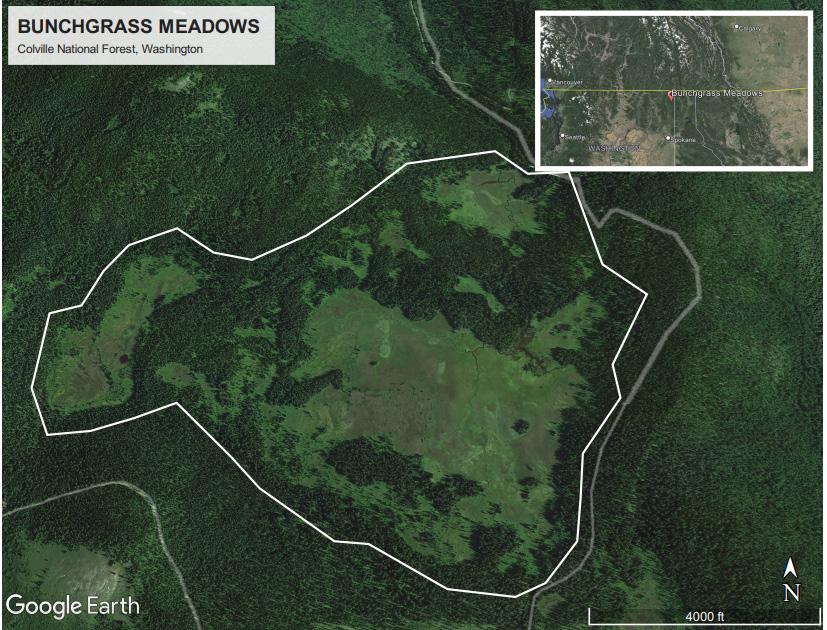
192 Wetland Science & Practice APRIL 2024
1 Email contact: Colin.MacLaren@pgn.com
Figure 1. Bunchgrass Meadows, Washington State, USA. The site is part of Colville National Forest, along the Washington-Idaho border (inset). (Image Source: Google Earth)

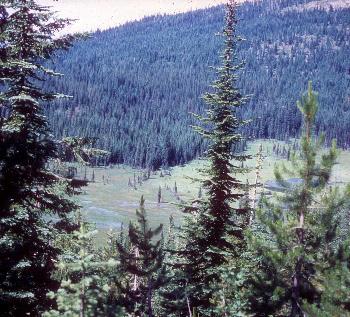

Wetland Science & Practice APRIL 2024 193
Figure 4. Aerial view of string and flark bog (patterned peatland) at Bunchgrass Meadows. (Image Source: Washington State Natural Heritage Program)
Figure 3. Subalpine fir and western white pine overlooking Bunchgrass Meadows. (Photo credit: U.S. Forest Service)
Figure 2. Oatgrass ringing sedge and cottongrass/spruce wetlands at Bunchgrass Meadows. (Photo credit: U.S. Forest Service)
subalpine sphagnum bog, subalpine fir/beargrass forest, and subalpine fir/Cascades azalea woodland that provided habitat for two sensitive plant species, meadow pussytoes (Antennaria corymbosa), beaked sedge (Carex rostrata). The subalpine fir/cascade azalea-beargrass (Xerophyllum tenax) plant community dominates upper-westerly slopes with high precipitation, and the subalpine fir/big huckleberry (Vaccinium membranaceum) community dominates the cool, relative dry sites (Figure 3). Bluejoint reedgrass (Calamagrostis canadensis) is common on bog moss string and flark dams (Figures 4 and 5) as well as in the transition from meadows to uplands. Mud sedge (Carex limosa) and beaked sedge (Carex rostrata) are also common on bog moss string and flark dams. Leafy tussock sedge (Carex aquatilis) and Northwest Territory sedge (Carex utriculata) are common in large flat fen sites. Holm’s rocky mountain sedge (Carex scopulorum var. prionophylla) plant association is common, and hooded ladies’ tresses (Sprianthes romanzoffiana; Figure 6) may be spotted on large, moderately sloping sub-irrigated bogs. Timber oatgrass (Danthonia intermedia) is dominant in the narrow band of
meadow on the edge of the upland forest. Farr’s willow/ few-flowered spikebrush (Salix farrige/ Eleocharis quinqueflora) is common on flat tall cottongrass sites where the terrain is slightly hummocky. Tall cottongrass (Eriophorum angustifolium ssp. subarcticum; Figure 7) and Engelmann spruce (Picea engelmannii) /Holm’s rocky mountain sedge communities are common throughout the RNA.
Twelve species of threatened, endangered or sensitive animals and fish have been documented at Bunchgrass Meadows, including woodland caribou (Rangifer tarandus ssp. caribou), Canada lynx (Lynx canadensis), bull trout (Salvelinus confluentus), grizzly bear (Ursus arctos horribilis), gray wolf (Canis lupus), Townsend’s big-eared bat (Corynorhinus townsendii), peregrine falcon (Falco peregrinus anatum), wolverine (Gulo gulo luteus), fisher (Martes pennanti), redband trout (Oncorhynchus mykiss), and great gray owl (Strix nebulosa).
Rare forested and emergent wetland plant communities identified and mapped as high conservation value by the Washington Department of Natural Resources (WDNR) include Carex aquatilis var. aquatilis fen, Picea engelman-
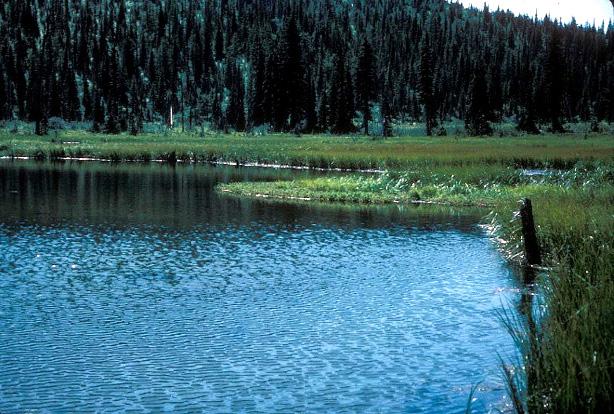
194 Wetland Science & Practice APRIL 2024
Figure 5. Flooded lowlands at Bunchgrass Meadows. (Photo Credit: U.S. Forest Service)
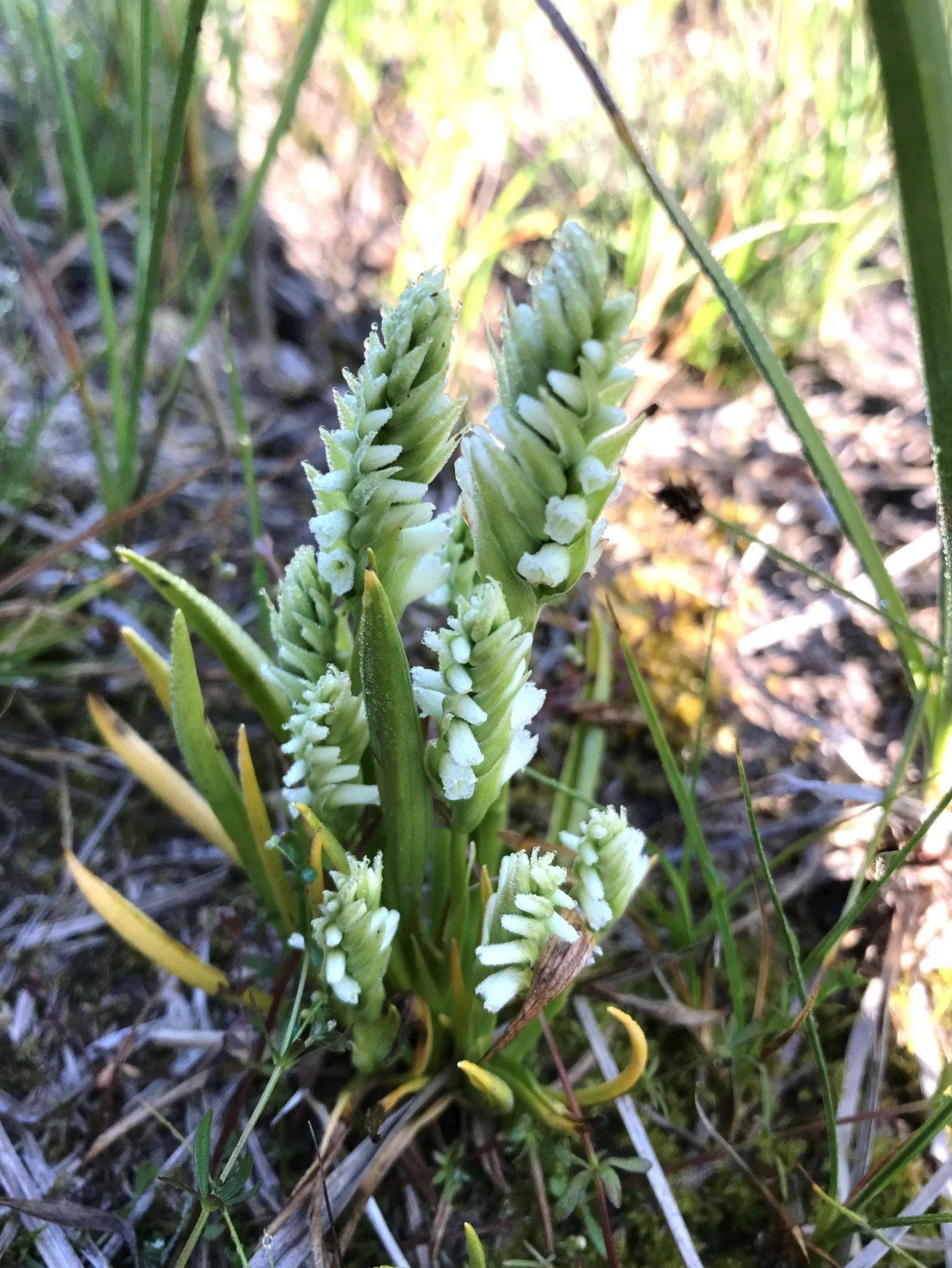
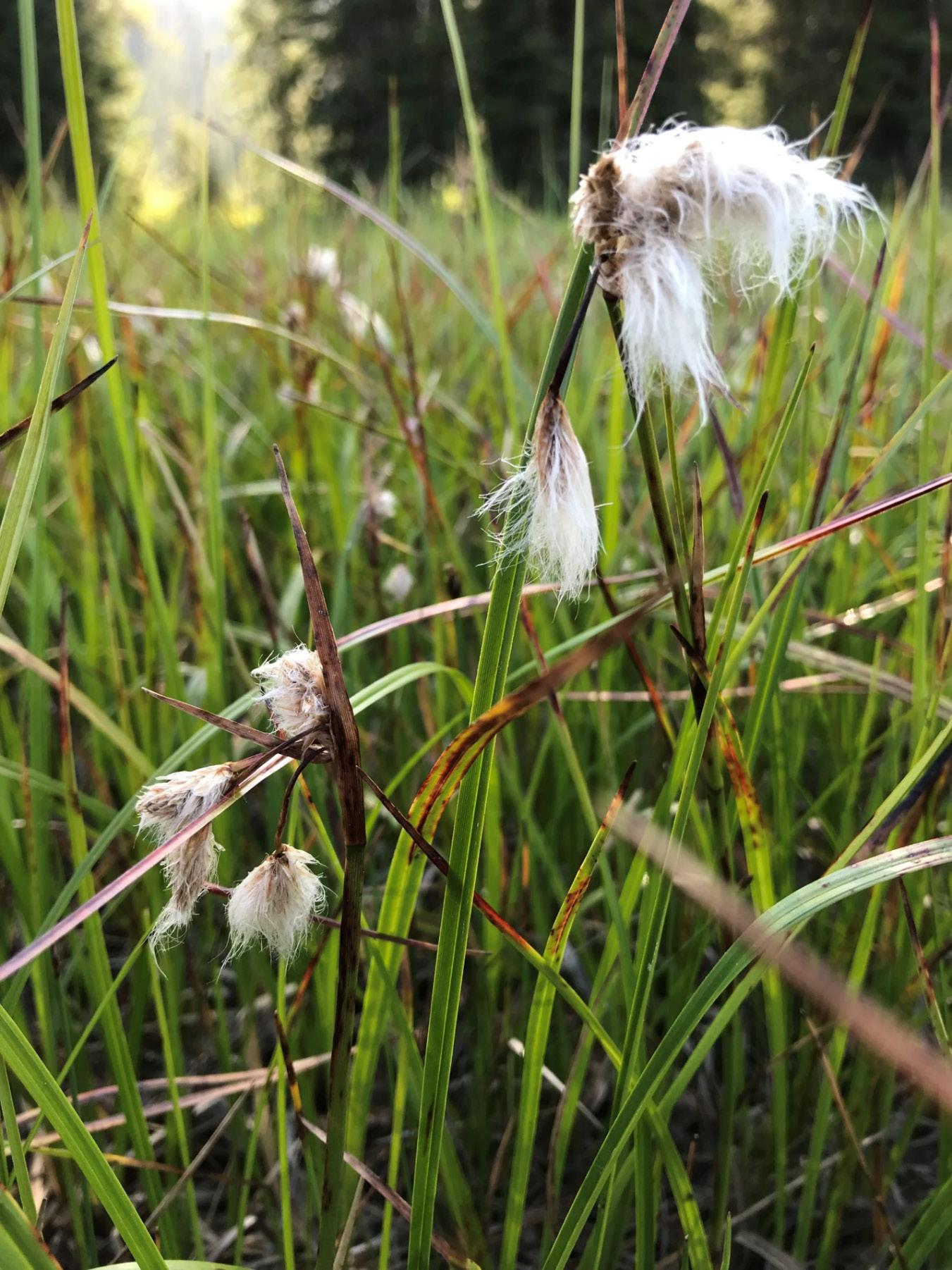
nii/Carex scopulorum var prionophylla swamp woodland, Carex scopulorum var prionophylla fen, Carex utriculata fen, Eleocharis quinqueflora fen, Salix farriae/Eleocharis quinqueflora shrub fen, Calamagrostis canadensis western wet meadow, Danthonia intermedia wet meadow, Carex limosa fen, Carex rostrata fen, and Eriophorum angustifolium ssp. angustifolium-Eleocharis quinqueflora/Sphagnum spp. fen. Washington Native Plant Society maintains a list of 132 plant species identified at Bunchgrass Meadows, only one of which is non-native.
Soils formed from volcanic ash, colluvium, and accumulated organic matter include borosaprists, Uncas muck, Vassar ashy silt loam, and Manley silt loam. The peatland and other elements of this unique wetland complex and neighboring forested uplands support populations of the rare plants and twelve species of threatened and endangered or sensitive animals above listed the USFS, WDNR, and US Fish and Wildlife Service (USFWS). Perhaps the most imperiled of the USFWS-listed species is the southern mountain caribou distinct population segment (DPS) of woodland caribou, which was listed as endangered in 2019.
Though not part of the 2012 designated critical habitat for the southern mountain caribou DPS, Bunchgrass Meadows is within the current range and provides habitat for this species and other listed threatened and endangered species, a testimony to the wildness of this place.
The nomination of Bunchgrass Meadows as a Wetland of Distinction came from longtime SWS - Pacific Northwest Chapter member Scott Luchessa, who noted “…it was clear this was a magical place. It is the only place in the lower 48 where I have heard gray wolves howling.” Through his research, Mr. Luchessa found that the wetland component potentially includes the southernmost patterned peatland in the coterminous USA. The high elevation fen component of the wetland was identified in the 2007 and 2011 WDNR Natural Heritage Plan as a high conservation need. “Upon visiting Bunchgrass RNA with fellow wetland scientists during this past year’s annual (SWS) meeting in Spokane” Mr. Luchessa wrote, “we found the system also appears to support tiny fingernail clams, a first for me. Hopefully, I will have the opportunity to visit this spectacular system many more times before my best days are behind me.”
Wetland Science & Practice APRIL 2024 195
Figure 7. Tall Cottongrass (Eriophorum angusitfolium). (Photo credit: Amanda Hendrix, USFS)
Figure 6. Hooded Ladies’ Tresses (Spiranthes romanzoffiana). (Photo credit: Amanda Hendrix, USFS)
Streams of Revenue: The Restoration Economy and the
Ecosystem It Creates
(Rebecca Lave and Martin Doyle, The MIT Press)
By R.C. Smardon
The book by Rebecca Lave and Martin Doyle is a critical examination of stream restoration banking drawing primarily from interviews of practitioners, bankers, regulators who are most actively involved with this practice to date. The book is also a critique of the restoration economy and ecosystem-based services ability to meet ecological and economic objectives.
I was very interested in this book having been involved with past wetland mitigation projects as well as wetland banking. I was also familiar with Rebecca Laves book Fields and Streams; Stream Restoration, Neoliberalism and the Future of Environmental Science (Lave 2012) which illuminated conflicts between market forces and environmental quality issues. This book was utilized when I wrote the book Revitalizing Urban Waterway Communities: Streams of Environmental Justice (Smardon. Moran, and Baptiste 2018).
Rebecca Lave is Chair of the Department of Geography at Indiana University. As stated previously, her 2012 book Fields and Streams was a revealing text on neoliberalism and environmental science as well as the conflicts in training and practice of stream restoration professionals. Martin Doyle is Professor of River Systems Science and Policy at Duke University where he is Director of the Water Policy Program. He is the author of The Source: How Rivers made America and America Remade its Rivers (Doyle 2019).
Wetland practitioners, regulators, and wetland researchers have long struggled with the role of science, the regulatory environment, and economics of wetland mitigation and banking (Smardon 2019). Lave and Doyle have presented an in-depth look at stream mitigation banking within this volume. They do so by reviewing stream restoration practice history, who the players are, and review step-by-step banking procedures with particular reference to the North Carolina context.
As explained by the authors within the book’s introduction — there are three major sections to the book. Chapters 2, 3 and 4 review the market for ecosystem services and how the regulatory market was created for stream restoration. The second section (chapters 5 and 6) draw upon the author’s social survey and field work to reveal how each of the key parties in stream mitigation banking function.

Within the final section of the book the authors describe the outcomes of stream mitigation banking from both ecological and economic market perspectives.
Those of us who are or were involved with wetland mitigation banking under the 2008 U.S. Army Corps of Engineers (USACOE) Clean Water Act guidance know this is a highly complex and challenging process. It seems that stream mitigation banking is equally so. What Lave and Doyle reveal throughout the book are three major findings.
1. As practiced in North Carolina and other USACOE jurisdictions the major model for stream restoration is the “natural channel” geomorphological configuration that stabilizes the stream channel;
2. The real ecological benefits or enhancement of biodiversity for such stabilization channel design is yet to be documented; and
3. The regulatory market driven conditions reward those who consistently propose projects that minimize both environmental and economic risk for wetland bankers, regulators and stream mitigation design practitioners.
Within the last chapter the authors offer some alternatives to the standard model of stream mitigation banking. One option would be to maximize certain functions by stream segment. Another option would be to allow the stream to find its own path versus engineered channel configurations. The third option would be to eliminate stream blockages and structures such as dams and let the stream reconfigure itself.
The authors present a detailed accounting of the stream mitigation banking practice from multiple perspectives as well as a probing critique of regulatory markets for such activity. This critique of ecosystem-based services a bit one
196 Wetland Science & Practice APRIL 2024 BOOK REVIEWS
sided. There are some positive aspects of ecosystem services as derived from the Millennium Ecosystem Assessment 2005. Also, I would have liked to have seen more coverage or examples of stream mitigation banking other than in North Carolina but realizes that this particular geographic area has had much more stream mitigation banking activity than [what?].
The value of Lave and Boyle’s book is that it provides a deeper examination of issues inherent both for stream and wetland mitigation banking which I have seen firsthand. So, stream and wetland mitigation banking practitioners, regulators, and policy researchers should all utilize this probing book.
Two Natural History Books on Louisiana Wetlands
by Kelby Ouchley (LSU Press)
By Ralph Tiner
In searching for books about the experiences of local naturalists in wetlands I came across two books written by Kelby Ouchley and published by Louisiana State University Press. The author is a former U.S. Fish and Wildlife Service refuge manager who grew up in the vicinity of Bayou D’Arbonne Swamp and after doing tours at other refuges ended up managing the one he grew up in: D’Arbonne National Wildlife Refuge. Through both books he conveys his life experiences in and around Louisiana swamps and love of nature.
The first book — Bayou-Diversity: Nature and People in the Louisiana Bayou Country — is a collection of short essays mainly on plant and animal life in southern Louisiana. First published in 2011, this book evolved from narratives he delivered about natural history for a local public radio station — KEDM. His essays make for entertaining quick reads and an excellent book for reading on vacations or on cold winter nights. The book was originally published in hardcopy, but the paperback edition was released in 2023. The essays are arranged in six loose chapters — the first three dealing with flora and fauna, while the last three deal with human interactions with nature and impacts. It is the kind of book that you can simply pick a topic and read it and move to another topic of interest...no need to read from page 1 to 218...very easy to read and entertaining.
His second book — Bayou D’Arbonne Swamp: A Naturalist’s Memoir of Place — published in 2022 appears to be an outgrowth of his first book but one that focuses on his experiences in and around the Swamp. This book was recognized as the 2023 winner of the John Burrough’s Medal for nature writing. Not surprisingly, his writing style is first
REFERENCES CITED
Doyle, M. 2019. The Source: How Rivers Made America and America Remade Its Rivers. WW Norton Company Inc., New York.
Lave, R. 2012. Fields and Streams: Stream Restoration, Neoliberalism, and the Future of Environmental Science. The University of Georgia Press, Athens, GA.
Lave, R. and M. Doyle. 2023. Streams of Revenue: The Restoration Economy and the Ecosystem It Creates. The MIT Press, Cambridge, MA and London, UK.
Millennium Ecosystem Assessment 2005. Our Human Planet: Summary for Decision Makers. Millennium Ecosystem Assessment. Island Press, Washington, DC.
Smardon, R.C. 2019. US Clean Water Act policy vs. wetland sciencenexus or not? Wetland Science and Practice 36 (1): 15-22.
Smardon, R.C., S. Moran, and A.K. Baptiste. 2018. Revitalizing Urban Waterway Communities: Streams of environmental Justice. Earthscan/ Routledge, London and New York.
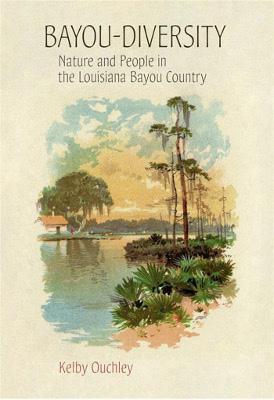
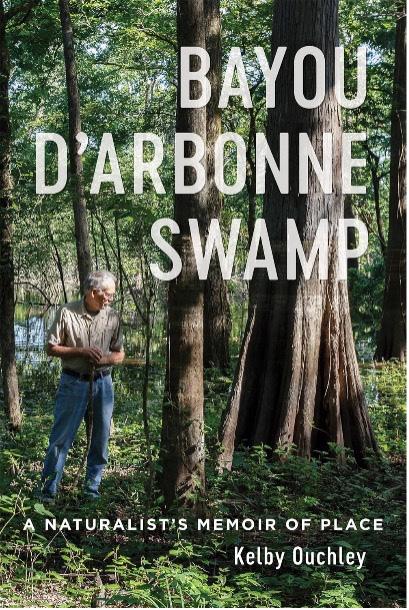
class and easy to read as well as informative and enjoyable. The Swamp is in northern Louisiana, just south of what is now Bayou D’Arbonne Lake (former swamp) — the largest man-made lake in the region. Kelby summarizes the history of the Swamp and various experiences of family, friends, indigenous peoples, and historical figures living in and around the swamp. He writes how people/government have changed the Swamp by damming a portion of the bayou that altered the natural flood pulse that once sustained the Swamp’s flora and aquatic life or by drilling natural gas wells that polluted the bayou and may have affected local water tables and flow from natural springs, for example. He also reflects on how the Endangered Species Act has helped bring back the Bald Eagle and American Alligator. Throughout the book he emphasizes the habitat requirements for common species in a successful attempt to have readers understand important relationships. One can easily see the writer’s passion for nature.
If you are looking for an entertaining book about wetland wildlife and the experiences of people in and around them, both of these books should be on your reading list.
Wetland Science & Practice APRIL 2024 197
Some Observations from a Summer Trip to Alaska
By Ralph Tiner
Last summer my wife and I went to Alaska for a couple of weeks. In my nearly 40 years of work with the U.S. Fish and Wildlife Service I never had the opportunity to experience Alaska’s wetlands, so I had to do it in retirement — one item on my bucket list. We started our trip in Anchorage and our first stop with the rental car was Potter Marsh which has a great boardwalk system traversing the marsh. To our surprise after walking just 100 yards, we saw a moose feeding in the shallow water...what a sight at our first stop. We then went to Seward and along the way stopped at the Alaska Wildlife Conservation Center and Exit Glacier. When back in Anchorage we stopped at 49th State Brewing where I had two pints of a delicious imperial stout — “Candy Bar” — brewed with peanuts, chocolate, and caramel...perfect for my sweet tooth (sorry but the beer was just so good I have to give it a shout-out). We also visited a high school classmate who was a teacher in Anchorage and spent a day in Talkeetna where we spoke with Aurora Dora, a local photographer who has captured some amazing images of the Aurora Borealis (check out images on her website: https://auroradora.com/). Here we also sampled some birch syrup made from White or Paper Birch (Betula papyrifera var. humilis and B. neoalaskana). On Day 3 we began our Princess land-sea cruise tour as
we headed north to Denali for a couple of days and then took the scenic train to Whittier (great views of Alaska’s wetlands on the way, despite the rain) and then to various ports via ship. I was hoping to see some bears in Denali and other places, but the salmon were not yet running, so bears were out of sight although I did see one running across a meadow at some distance. I also saw a few along with other animals common to the state at the Alaska Wildlife Conservation Center where they rescue injured/orphaned wildlife. Some high points of the trip were seeing Denali in all its glory, a female moose with calf at Horseshoe Lake, wildflowers in bloom along the Savage River Trail and the Savage Alpine Trail (exhausting but great time for wildflower photography), a hike across a local bog at Hoonah (Icy Strait Point), a hike through a temperate rain forest (Tongass National Forest) to Mendenhall Glacier, and seeing Humpback Whales (Megaptera novaeangliae) bubblenet feeding in Auke Bay, plus views of a few other glaciers and whales during the cruise. If you don’t know what bubble-net feeding is ... check out this website: https:// www.youtube.com/watch?v=z00G0RxeSP0. There’s still more to see in Alaska, so we’ll probably be heading back in late summer 2025 to travel inland.
Here’s some mostly wetland-centric images from the trip.

198 Wetland Science & Practice APRIL 2024 NOTES FROM THE FIELD
Potter Marsh, south of Anchorage on the Seward Highway. Our first wetland stop in Alaska where we saw our first moose on this trip.


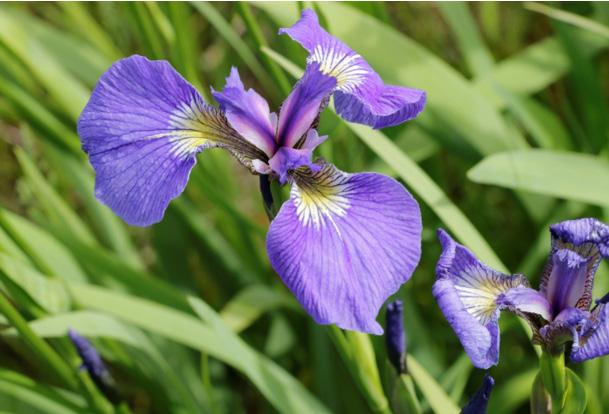

Wetland Science & Practice APRIL 2024 199
Wetland bordering Turnagain Arm near Girdwood.
Wild Flag or Beachhead Iris (Iris setosa) from a wet meadow along the road to the Alaska Wildlife Conservation Center.
Shrubby Cinquefoil (Dasiphora fruticosa) – common in both wetlands and nonwetlands in Alaska.
Brown Bear (Ursa arctos) and Raven (Corvus corax) at Alaska Wildlife Conservation Center, near Girdwood.
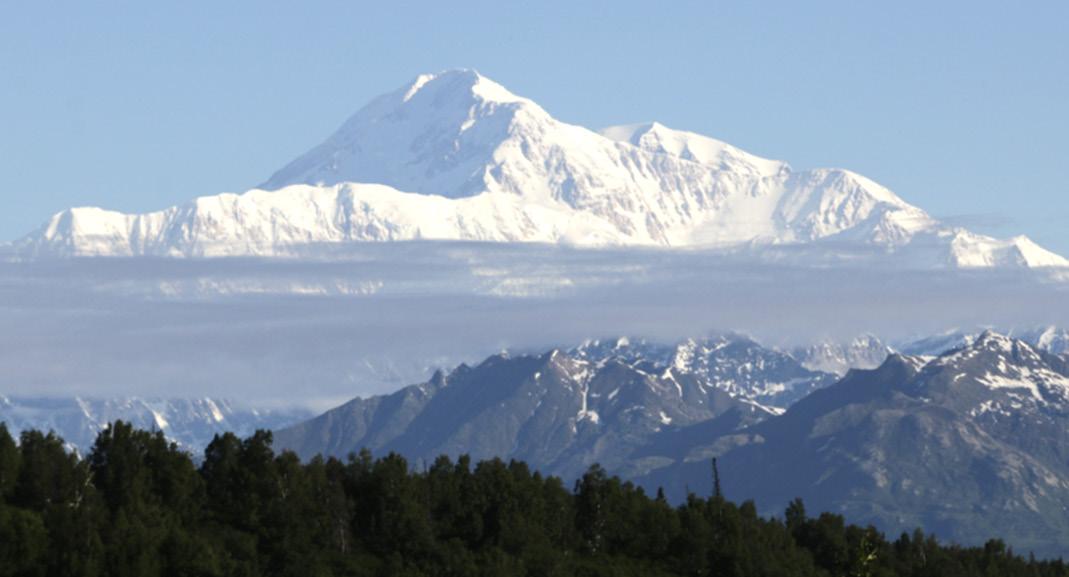
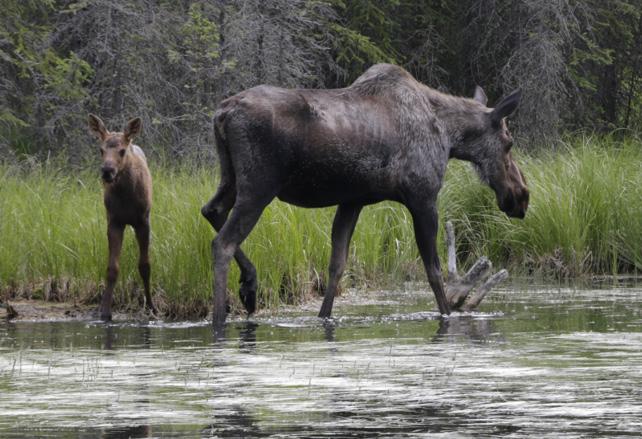


200 Wetland Science & Practice APRIL 2024
Denali on a clear day – July 13, 2023.
Cow moose and calf (Alces alces) at Horseshoe Lake, Denali National Park.
Old beaver dam along the edge of Horseshoe Lake, Denali National Park. View of the Savage River and its floodplain at Denali National Park.




Wetland Science & Practice APRIL 2024 201
A large patch of Dwarf Fireweed (Chamerion latifolium) was observed on a gravel bar along the Savage River.
Marsh Grass of Parnassus (Parnassia palustris) from floodplain of Savage River, Denali NP.
Tall Cottongrass (Eriophorum angustifolium) from Savage River floodplain.
Another portion of the Savage River floodplain; note cotton-grasses in foreground.



202 Wetland Science & Practice APRIL 2024
View of Alaska wetland (in the rain) taken from the train from Denali to Whittier.
Arctic Ground Squirrel (Spermophilus parryii) along the Savage Alpine Trail auditioning for a spot on Wild Kingdom.
View of coastal marsh and tidal flat south of Anchorage from the train to Whittier.
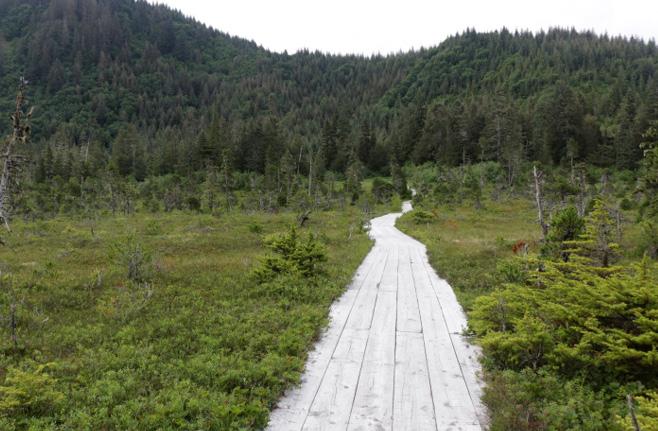

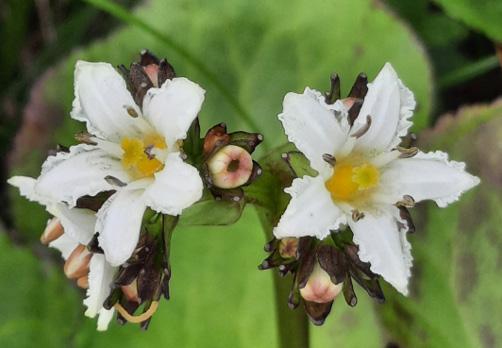

Wetland Science & Practice APRIL 2024 203
Boardwalk across bog near Spasski Creek, Hoonah (Icy Strait Point). The bog turned out to be the high point of this excursion as there were no bears to be seen along the creek as the salmon had not yet returned.
Deercabbage (Nephrophyllidium crista-galli) from bog near Spasski Creek, Hoonah.
Buckbean (Menyanthes trifoliata) from bog, near Hoonah.
Scentbottle (Platanthera dilatata) from bog near Spasski Creek, Hoonah.
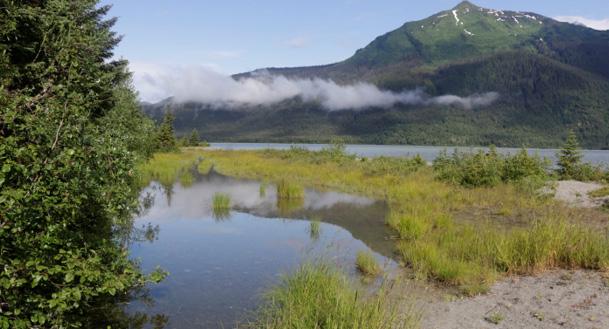


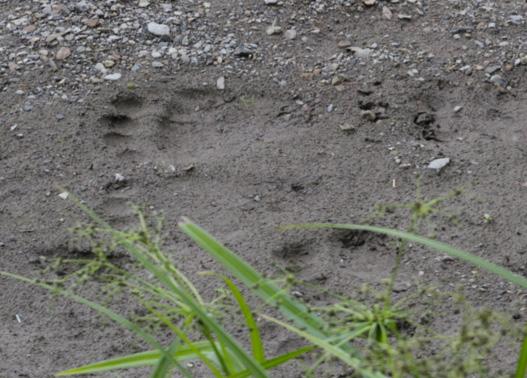

204 Wetland Science & Practice APRIL 2024
Wetland along Lake Mendenhall near Mendenhall Glacier, north of Juneau.
Cloudberry (Rubus chamaemorus) from bog, near Hoonah.
Mendenhall Glacier emptying into Mendenhall Lake, Juneau.
Bear track along Spasski Creek, near Hoonah (Icy Strait Point). This was as close to a bear that we got in the wild.
Temperate rainforest at Tongass National Forest.
Listed below are some links to some random news articles that may be of interest. Links from past issues can be accessed on the SWS website news page. This section includes links to mostly newspaper articles that may be of interest. Members are encouraged to send links to articles about wetlands in their local area. Please send the links to WSP Editor at ralphtiner83@gmail.com and reference “Wetlands in the News” in the subject box. Thanks for your cooperation.
For another source on the latest news about wetlands and related topics, readers are referred to the National Association of Wetland Managers website (formerly the Association of State Wetland Managers). Their “Wetland News Digest” includes links to government agency public notices and newspaper articles that should be of interest, especially dealing with wetland regulations, court cases, management, and threats: https://www.nawm.org/publications/wetland-news-digest.
Why Are Alaska’s Rivers Turning Orange?
Bird that migrates to Victorian wetlands slated for wind industry terminal added to threatened species list
Hundreds of manatees gather at Florida springs to keep warm
23 million-year-old petrified mangrove forest discovered hiding in plain sight in Panama West Norfolk peat wetland project gets £210k for new reserve
Mendenhall wetlands area to get first new full map since 1979
LSU awarded $780,000 to help Louisiana tribe protect coastal land
Keep an eye out for invasive cannibal frogs, says DNR
California frog reintroduction is rare victory against fungal pandemic
Boxing clever — this engineered wetland is a holistic solution to SA’s water treatment problems
The Lost Wonders of a Waterless Wetland
Wetland plan to cut down on sewage releases
Colorado Town Appoints Legal Guardians to Implement the Rights of a Creek and a Watershed
Astro-Botany Breakthrough: Earth’s Smallest Plant Takes On Hypergravity
Larkspur halts tidal marsh restoration amid landfill discovery
Evaporation and Transpiration From Multiple Proximal Forests and Wetlands
Revealing the hidden carbon in forested wetland soils
A Historic and Devastating Drought in the Amazon Was Caused by Climate Change, Researchers Say
Cleaning Water Naturally the Ancient Maya Way
The Wetlands of Nebraska Project
Pevensey farmers work together to preserve wetland habitat
Longwood Shola, Karaivetti sanctuary in Tamil Nadu recognised as Ramsar sites, tally increases to 16
Nema: Wetlands continue to face serious threats
SA gets its 30th Ramsar wetlands site, near Dullstroom in Mpumalanga
Pakistan bucks global trend with 30-year mangrove expansion
Chat Moss peat bog bought by wildlife trust for restoration
New wetland habitat maps will help capture Juneau’s ‘wildlife and fish factory’
Creating an urban wetland from a former dump site in FDR Park
Wetlands and Wellbeing: Why it’s Important to Protect
Texas’ Wetlands
How this 100-year-old woman helped save one of the Bay Area’s remaining wetlands
Hundreds of formerly federally regulated Colorado wetlands and streams are unshielded right now
Bofedales: Natural Infrastructures and Andean Landscapes
Wetland Centers and the Fight Against Climate Change
A new map shows how much carbon dioxide is stored in Oregon’s Coos Bay estuary
Study shows methane emissions from wetlands increase significantly over high latitudes
The Amazon’s crucial water cycle faces collapse, scientists say
Antarctica’s miniature moss ‘forests’ reveal shifts in climate across thousands of years
Risks to Myanmar’s last saltwater crocs point to coastal conservation needs
Suffolk Wildlife Trust’s Worlingham Marshes project gets £2m in lottery funding
Tribe Making Play To End Oil Development At Big Cypress National Preserve
The East Coast is Sinking
Are artificial wetlands, nearing completion at California’s Salton Sea, the future of the Great Salt Lake?
NASA Images Show How Death Valley Lake Was Refilled by Atmospheric River
King’s Series nature reserve ‘huge step for recovery’
Greenland’s ice sheet is melting and being replaced by vegetation, finds major satellite analysis
Climate change: Efforts to reduce global warming hurting manatees in an unusual way
High methane concentrations in tidal salt marsh soils: Researchers seek to discover where it goes
A new Indiana bill will weaken protections over wetlands
Wetland Science & Practice APRIL 2024 205 WETLANDS IN THE NEWS
WETLAND BOOKSHELF
Listed below are some wetland books that have come to our attention over the years. Please help us add new books and major reports to this listing. If your agency, organization, or institution has published new publications on wetlands, please send the information to Editor of Wetland Science & Practice at ralphtiner83@gmail.com. Your cooperation is appreciated.
BOOKS
• Bayou-Diversity: Nature and People in the Louisiana Bayou Country
• Bayou D’Arbonne Swamp: A Naturalist’s Memoir of Place
• History of Wetland Science: A Perspective from Wetland Leaders
• An Introduction to the Aquatic Insects of North America (5th Edition)
• Wading Right In: Discovering the Nature of Wetlands
• Sedges of Maine
• Sedges and Rushes of Minnesota
• Wetland & Stream Rapid Assessments: Development,Validation, and Application
• Eager: The Surprising Secret Life of Beavers and Why They Matter
• Wetland Indicators – A Guide to Wetland Formation, Identification, Delineation, Classification, and Mapping
• Wetland Soils: Genesis, Hydrology, Landscapes, and Classification
• Creating and Restoring Wetlands: From Theory to Practice
• Salt Marsh Secrets. Who uncovered them and how?
SWS JOURNAL
What’s New in the SWS Journal- WETLANDS?
• Remote Sensing of Wetlands: Applications and Advances.
• Wetlands (5th Edition).
• Black Swan Lake – Life of a Wetland
• Coastal Wetlands of the World: Geology, Ecology, Distributionand Applications
• Florida’s Wetlands
• Mid-Atlantic Freshwater Wetlands: Science, Management,Policy, and Practice
• The Atchafalaya River Basin: History and Ecology of an American Wetland
• Tidal Wetlands Primer: An Introduction to their Ecology, Natural History, Status and Conservation
• Wetland Landscape Characterization: Practical Tools, Methods, and Approaches for Landscape Ecology
• Wetland Techniques (3 volumes)
• Wildflowers and Other Plants of Iowa Wetlands
• Wetland Restoration: A Handbook for New Zealand Freshwater Systems
• Wetland Ecosystems
• Constructed Wetlands and Sustainable Development
• Tussock Sedge: A Wetland Superplant
• Waubesa Wetlands: New Look at an Old Gem
The following articles appear in Volume 43, issue 6 of WETLANDS, journal for the Society of Wetland Scientists.
Connecting Wetland Flooding Patterns to Insect Abundance Using High-Resolution Inundation Frequency Data
Phosphorus Fluxes in a Restored Carolina Bay Wetland Following Eight Years of Restoration
Knowledge of Spawning Phenology may Enhance Selective Barrier Passage for Wetland Fishes
Revisiting hydro-ecological impacts of climate change on a restored floodplain wetland via hydrological / hydraulic modelling and the UK Climate Projections 2018 scenarios
Seasonal Sediment Dynamics in a Constructed and Natural Tidal Marsh in the Northern Gulf of Mexico
The Relationship Between the Establishment of Aquatic Macrophytes and the Death of Mangroves in a South American Estuary: New Assessments of a Serious Environmental Problem
Temperature and Precipitation Trends of the Shoulder Seasons at Polar Bear Pass (Nanuit Itillinga) – A Ramsar Wetland of Importance, Nunavut
Morphoanatomical Analysis and Diversity of Andean Urban Wetland seed Banks: A tool for Ecological Rehabilitation
Assessing Nutrient Assimilation by Wetland Impoundments Across Environmental Gradients
206 Wetland Science & Practice APRIL 2024
About Wetland Science & Practice (WSP)
Wetland
Science and Practice (WSP) is the SWS quarterly publication aimed at providing information on select SWS activities (technical committee summaries, chapter workshop overview/abstracts, and SWS-funded student activities), articles on ongoing or recently completed wetland research, restoration, or management projects, freelance articles on the general ecology and natural history of wetlands, and highlights of current events. The July issue is typically dedicated to publishing the proceedings of our annual conference. WSP also serves as an outlet for commentaries, perspectives and opinions on important developments in wetland science, theory, management and policy. Both invited and unsolicited manuscripts are reviewed by the WSP editor for suitability for publication. When deemed necessary or upon request, some articles are subject to scientific peer review. Student papers are welcomed. Please see publication guidelines herein. Electronic access to Wetland Science and Practice is included in your SWS membership. All issues published, except the current issue, are available via the internet to the general public. The current issue is only available to SWS members; it will be available to the public four months after its publication when the next issue is released (e.g., the January 2022 issue will be an open access issue in April 2022). WSP is an excellent choice to convey the results of your projects or interest in wetlands to others. Also note that as of January 2021, WSP will publish advertisements, contact info@sws. org for details.
HOW YOU CAN HELP
If you read something you like in WSP, or that you think someone else would find interesting, be sure to share. Share links to your Facebook, Twitter, Instagram and LinkedIn accounts.
Make sure that all your SWS colleagues are checking out our recent issues, and help spread the word about SWS to non-members!
Questions? Contact editor Ralph Tiner, PWS Emeritus (ralphtiner83@gmail.com).
WSP Manuscript – General Guidelines
LENGTH:
Approximately 5,000 words; can be longer if necessary.
STYLE:
See existing articles from 2014 to more recent years available online at:
https://members.sws.org/wetland-science-and-practice Standard format/outline for articles: Title, authors (affiliations and correspondence author email in footnotes), followed by Abstract, then Text (e.g., Introduction, Methods, Results, Discussion, and Conclusion), and ending with References. All articles must have an abstract.
TEXT:
Word document, 12 font, Times New Roman, single-spaced; keep tables and figures separate, although captions can be included in text. For reference citations in text use this format: (Smith 2016; Jones and Whithead 2014; Peterson et al. 2010). Do not perform formatting (e.g., capitalization of headings and subheadings). Do not indent paragraphs…just separate paragraphs by lines.
FIGURES:
Please include color images and photos of subject wetland(s) as WSP is a full-color e-publication. Image size should be less than 1MB; 500KB may work best for this e-publication. Figures should be original (not published elsewhere) or in the public domain. If figure was published elsewhere (copyrighted), it is the responsibility of the author to secure permission for use. Be sure to provide proper credit in the caption.
Reference Citation Examples
• Claus, S., S. Imgraben, K. Brennan, A. Carthey, B. Daly, R. Blakey, E. Turak, and N. Saintilan. 2011. Assessing the ex-tent and condition of wetlands in NSW: Supporting report A – Conceptual framework, Monitoring, evaluation and re-porting program, Technical report series, Office of Environ-ment and Heritage, Sydney, Australia. OEH 2011/0727.
• Clements, F.E. 1916. Plant Succession: An Analysis of the Development of Vegetation. Carnegie Institution of Washington. Washington D.C. Publication 242.
• Colburn, E.A. 2004. Vernal Pools: Natural History and Conservation. McDonald & Woodward Publishing Company, Blacksburg, VA.
• Cole, C.A. and R.P. Brooks. 2000. Patterns of wetland hydrology in the Ridge and Valley Province, Pennsylvania, USA. Wetlands 20: 438-447.
Please be sure to add the doi link to citations where possible.
If you have questions, please contact the editor, Ralph Tiner at ralphtiner83@gmail.com
Wetland Science & Practice APRIL 2024 207 WSP SUBMISSION GUIDELINES
2024 Advertising Prospectus

Monthly Newsletter
The SWS monthly newsletter is sent to approximately 3,000 members around the world, and enjoys an open rate between 40-50%, which is well above industry average. Place your organization in front of leading environmental scientists monthly with an ad that links to your website.
$100
• Ad Format: .jpeg or .png
• Distribution Date: On or around the 15th of each month Price
$90 ($270 total)
• Ad Due Date: Artwork and link URL due on the first of the month in which the ad is to run.
Website
$80 ($480 total)
$70 ($840 total)
• Size Specifications: 300 pixels wide x 250 pixels tall, 72 dpi
The SWS website boasts nearly 200 daily visitors annually and is a user-friendly, engaging, and SEO optimized format. By purchasing ad space on sws.org, you will increase the visibility of your product or service directly to our audience of wetland professionals, academics, and other science-based fields that will benefit the most from what your company has to offer.
Ad Begins
• Pricing: $300 quarterly; $1,000 yearly
• Ad Format: .jpeg or .png
• Size Specification: 300 pixels wide x 250 pixels tall, 72 dpi
Wetland Science & Practice (WSP)
• Ad Due Date: Artwork and link URL due one week prior to beginning run date
• Ad Begin Date: Ad uploaded the first day of the first month of the quarter
WSP is the SWS quarterly publication aimed at providing information on select SWS activities (technical committee summaries, chapter and section workshop overview/abstracts, and SWS-funded student activities); brief summary articles on current or recently completed wetland research, restoration, or management projects; information on the general ecology and natural history of wetlands; and highlights of current events. It is distributed digitally, with over 2,000 impressions and more than 300 reads in the first six months after release.
• Ad Format: Press quality .pdf with images rendered at 300 or higher dpi
• Ad Due Date: Artwork is due on the 15th of the month prior to the month of publication
• Distribution Date: WSP is published on or around the middle of the month of publication
208 Wetland Science & Practice APRIL 2024
Quarter 1 Quarter 2 Quarter 3 Quarter 4
Due Date January 2 March 27 June 24 Sept 25
Ad
January
April 3 July 1 October 2
9
1x 3x 6x 12x
(per ad)
Pricing and Print Specifications 1x 2x 3x 4x Full page (7.5” x 10” tall) $275 $250 $225 $200 Half page (7.5” x 4.625” tall) $175 $160 $145 $130 Quarter page (3.625 ” x 4.625” tall) $120 $110 $100 $90
January issue April issue July issue October issue Ad Due Date December 15 March 15 June 15 September 15 Issue Published January 3 April 3 July 5 October 4 Interested in targeted exposure to SWS members? Contact info@sws.org | www.sws.org
Coastal Wetlands of the Wilderness Lakes System, South Africa, Photographed by Douglas Macfarlane.

 Ralph Tiner WSP Editor
Ralph Tiner WSP Editor





 Susan Galatowitsch, Ph.D. University of Minnesota SWS President
Susan Galatowitsch, Ph.D. University of Minnesota SWS President
































































